An In-Depth Look at all the MB&F Legacy Machines Since 2011 (And an LMX To Come Soon…)
The Legacy Machine celebrates its tenth anniversary, it's time to look back and chart its evolution over the past ten years.
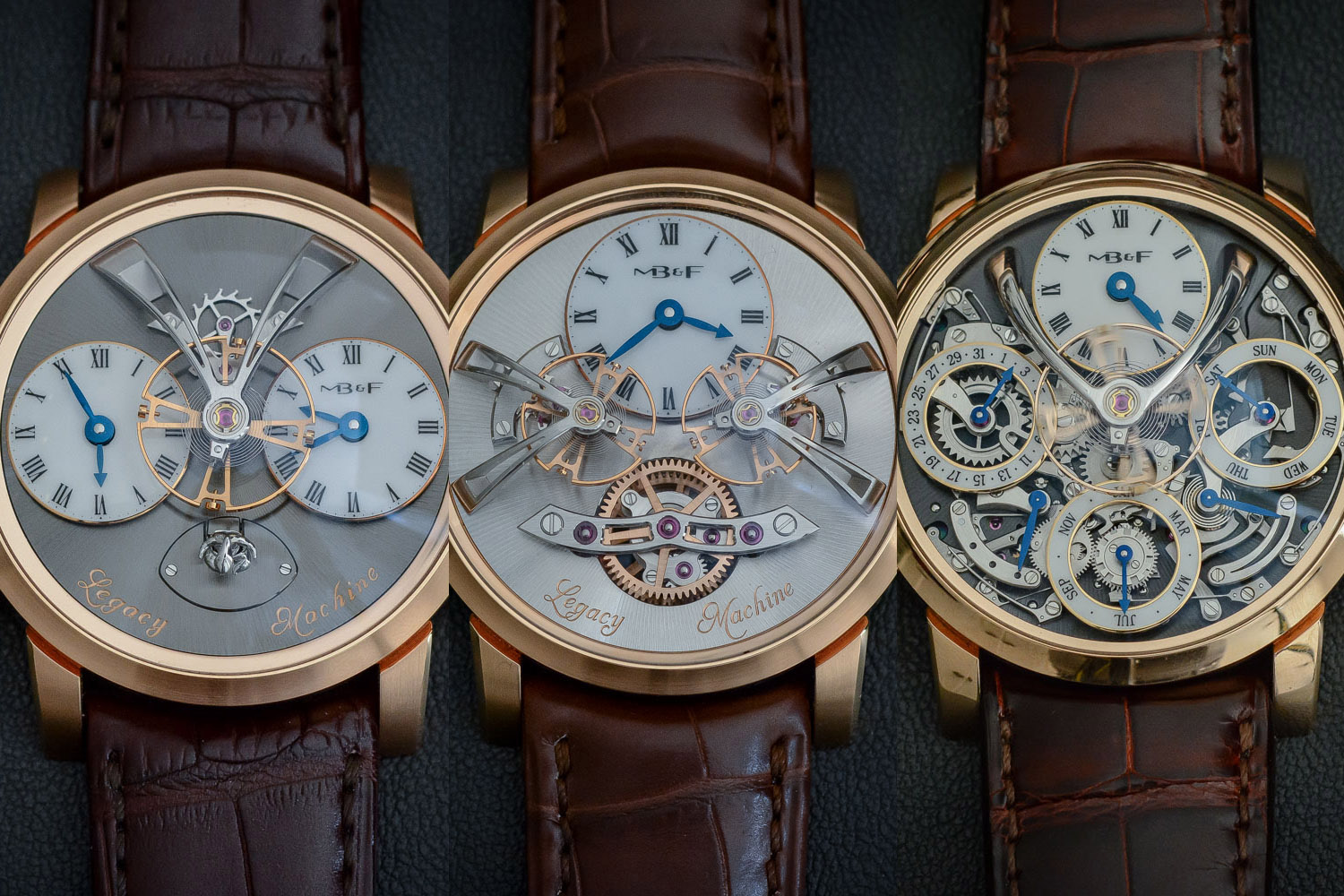
The MB&F Legacy Machine is coming up for its tenth anniversary. Just ahead of the launch of the LMX special anniversary model to mark the LM’s first decade of life, we’ve decided to take a trip down memory lane and recall all LM models produced by MB&F to date. Our in-depth retrospective of the Legacy Machine, which MONOCHROME has covered since its fledgeling debut in 2011, looks at how the model that shocked fans of MB&F’s galactic watches has evolved over the past ten years to become a solid pillar of the brand.
Flights of Fancy
By 2011, just six years after its founding, MB&F had landed four Horological Machines on our Blue Planet. Four machines that seem to have sailed in from another galaxy, the HM family set the tone for the nonconformist, wildly creative attitude towards watchmaking embraced by founder Max Büsser. Inspired by Büsser’s childhood fantasies of sci-fi and outer space adventures, MB&F’s trajectory was clearly galactic. With their retro-futuristic 3D cases and unorthodox displays, Horological Machines shook up the genteel world of watchmaking and earned the brand a cult following.

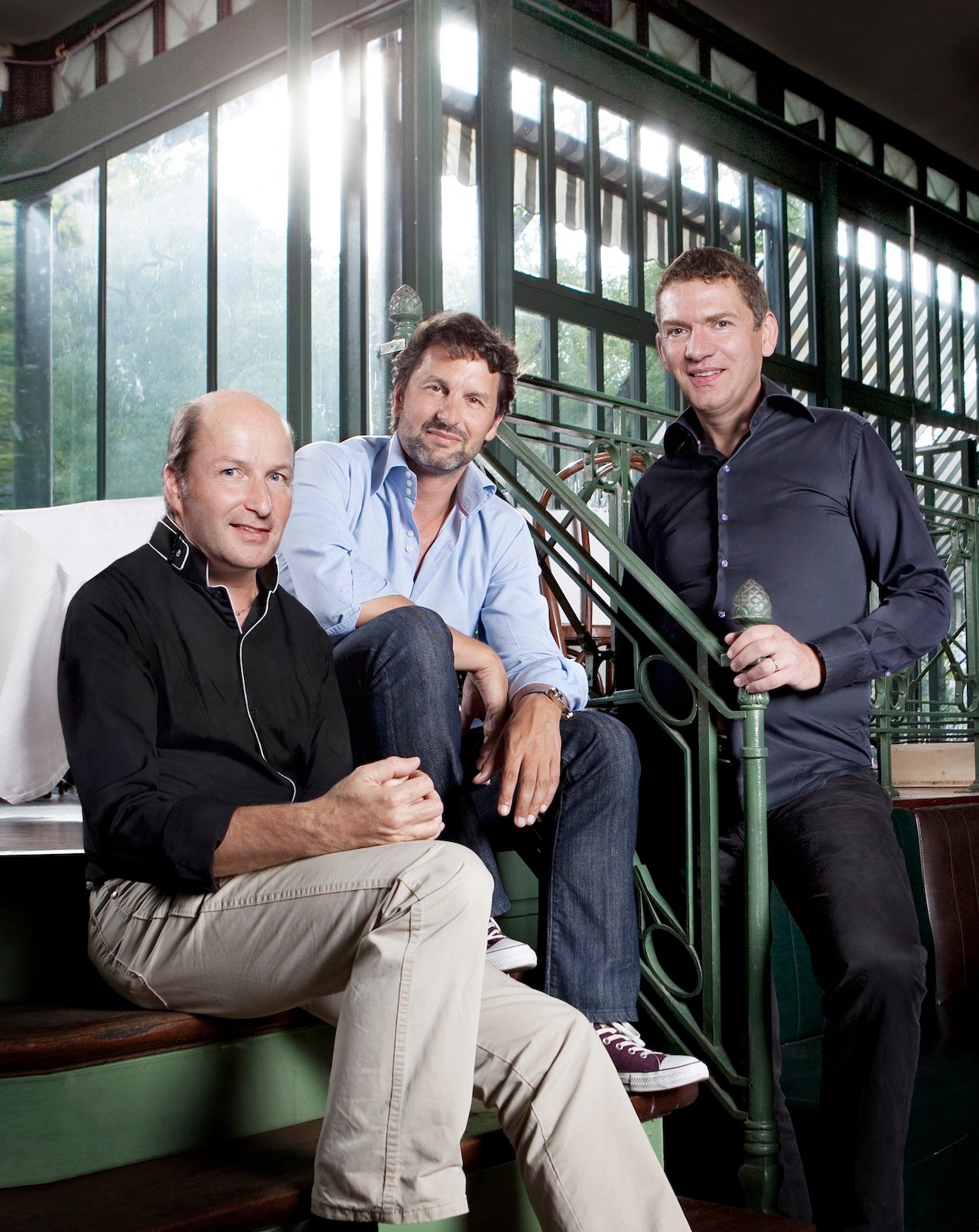
Then in 2011, something alien landed at MB&F: the Legacy Machine 1. It was round, it was classic, it was consensually beautiful, it even had two white lacquered registers with Roman numerals, it had blued-gold hands, and it was called Legacy Machine! What was going on? Had Büsser crash-landed his interstellar spaceships in favour of a traditional, round watch? What if Büsser, instead of being friends with Voutilainen, Mojon, Sarpaneva and the likes, would have been friends with these two fellas below? (Jules Verne on the left, Gustave Eiffel on the right)
The Legacy Machine was Büsser’s tribute to some of the great horological innovations and Grand Master watchmakers of the 19th century, with a distinctive MB&F twist. Büsser was obsessed with an idea: “What would have happened,” he mused, “if I was born in 1867, one hundred years before my actual year of birth? What watch would I have conceived with the help of my friends?”
Instead of turning to his galactic muses, Büsser flew back in time to explore the fantastic Voyages Extraordinaires of Jules Verne, the engineering miracles of Gustav Eiffel and the microcosmic world of 19th-century pocket watches. His musings materialised in the Legacy Machine 1, a watch that made history as the first piece to take home two prizes in the same year at the 2012 Grand Prix d’Horlogerie de Genève. Although many feared that the LM marked a more orthodox direction for the brand, they were wrong.
After ten years of life, the Legacy Machine cohabits in perfect harmony alongside its extraterrestrial HM brothers and a growing family of whimsical table clocks.
LM Family Traits
Reinterpreting certain aspects of traditional watchmaking with a hearty dose of MB&F verve, Büsser decided to position the balance wheel dial side under a spectacular V-shaped arching bridge. To protect the dial and the elevated arched bridge, Büsser envisioned a high-domed sapphire crystal similar to yesteryear’s bell jars used to exhibit exotic specimens. The kinetic sculptural appeal of MB&F watches was not abandoned on the LM; the mesmerising flying balance wheel provided the motion while the beautiful arched bridge, borrowed from the Eiffel tower, and the slightly raised counters added the dynamic architectural touch we associate with the brand.
MB&F (Max Büsser & Friends) is strong on joint ventures, inviting the very best to help materialise the brand’s wild flights of fancy. For the first Legacy Machine, Büsser turned to friends Jean-François Mojon to develop the movement and Kari Voutilainen to execute the traditional finishings and ensure they were historically accurate. Collaborations with watchmakers, movement developers, artists, engravers, and watch brands are very much a part of MB&F’s philosophy.
Since 2011, the Legacy Machine has appeared in countless guises, spawned eight unique calibres and escalated the complications ladder to extreme heights incarnated by the LM Perpetual and the LM Thunderdome with its triple-axis regulator. With a little help from MB&F’s friends, watchmaking genius Stephen McDonnell pulled off a fundamental re-engineering of the perpetual calendar complication on board the LM Perpetual of 2015 and tourbillon specialist Eric Coudray collaborated on the vertiginous triple-axis tourbillon.
Common denominators across all LM models are round cases, an exposed balance wheel held in place by an arched bridge, lacquered registers with Roman numerals and blued-gold hands, high-domed sapphire crystals and the stellar MB&F talent for showmanship. In keeping with the finishings found on historic timepieces, a special mention must go to the impeccable Haute Horlogerie finishings of the Legacy Machine family supervised by Voutilainen: hand-bevelled and polished angles, large gold chatons, Geneva waves on the bridges, hand-engraved surfaces, mirrored curves, etc.
The Evolutions
LM1 (2011)
The first Legacy Machine debuted in 2011 with a conventional round case but a highly unconventional dial/movement. Breaking with the style of the Horological Machines preceding it, the steampunk vibe of LM1 reminded our founder Frank Geelen of something Jules Verne’s might have conjured up in Twenty Thousand Leagues Under the Sea. Housed in a 44mm x 16mm case (gold, platinum and titanium), the three-dimensional GMT movement, developed by Jean-François Mojon, featured a bespoke 14mm flying balance wheel in the centre of the dial.
Büsser’s concept for the LM was to celebrate the innovations and innovators of 19th-century watchmaking. Although the exposed position of the balance wheel was unusual, the balance wheels of antique pocket watches were also large; a feature Büsser adopted as a nod to traditional watchmaking. Other features, like the white, stretched lacquered dials with black painted Roman numerals and blued hands, were also deployed to capture the mood of antique pocket watches. Kari Voutilainen, the famous Finnish watchmaker, oversaw the impressive Haute Horlogerie finishings designed to evoke the charm of old pocket watch calibres.
However, the LM1 was an MB&F creation and, as such, needed to transcend the limits of a traditional timepiece. What made it truly unique was the arched skeletonised bridge spanning the balance (inspired by the Eiffel tower), which in turn glided over the two dials at a sedate pace of 18,000vph/2.5Hz. Every element on the dial, including the world’s first vertical power reserve indicator designed to look like a sextant, reached up beyond the flat base to engage the viewer. Another rare and convenient feature of the LM1 was that both time zones could be set independently.
The radical change of direction for MB&F paid off, and the LM1 swept up not one but two prizes (Best Men’s watch and Public Prize) at the prestigious GPHG 2012 awards. Discontinued in 2017 after six years of fruitful life, the LM1 glided across the stage in a stainless steel case for its swan song.
LM2 (2013)
Two years later, MB&F unveiled Legacy Machine 2, this time celebrating the historic double regulator and the geniuses behind this invention (Breguet, Berthoud and Janvier). Instead of flaunting one flying balance wheel on the dial, the LM2 duplicated the viewing pleasure and placed two 11mm balance wheels in parallel.
Another novelty was the incorporation of a planetary differential to transmit the average rate of the dual regulators to a single gear train driving the hour and minute hands. Unlike Breguet and Janvier, whose double regulators relied on resonance to average the rate of the two balances, the distance between the balance wheels of the LM2 was meticulously calculated to avoid the phenomenon of resonance. Similar to Philippe Dufour’s Duality, the rates of the two balances are averaged by a differential for increased accuracy.
The design language of the LM2 followed directly on the heels of the LM1 with a round 44mm case in precious metals (platinum, titanium and red gold), a white lacquered dial with Roman numerals and blued hands for the time and the high-domed sapphire glass. Like the LM1, the movement of Legacy Machine 2 was developed (to MB&F’s specifications) by watchmaker Jean-François Mojon and independent Finnish watchmaker Kari Voutilainen was in charge of the superlative 19th-century style hand-finishings.
LM101 (2014)
The LM101 was revolutionary on many fronts: it was smaller than its siblings; it was simpler; it was the first LM with an in-house movement, and it was more ‘accessible’. Presented at Baselworld 2014, the LM101 displayed all the family’s hallmark features but was toned-down in size and functionality. Shrinking from 44mm to 40mm, and offering hours, minutes and a power reserve indicator, the gold LM101 was a ‘volks’ version of the Legacy Machine.
Another defining feature of LM101 was its asymmetrical layout. The hours and minutes were placed on a white lacquered disc at 2 o’clock, the smaller power reserve disc at 6 o’clock, and although the suspended balance wheel was smack in the centre, the spectacular double-arched bridge was relocated to the left upper quarter of the dial. The movement was developed and assembled in-house with Kari Voutilainen as a consultant for the design movement and finishing specifications.
Revisited in a gorgeous ‘Frost’ dial version, the LM101 also appeared in platinum and palladium. A few years later, it would become the chassis for the MB&F x H. Moser & Cie. collaboration piece.
LM Perpetual (2015)
The LM Perpetual was serious horological stuff. Although it’s fair to say that MB&F’s watches have always had complicated displays and complex cases, the LM Perpetual heralded the brand’s foray into bona fide Haute Horlogerie terrain. Developed with independent watchmaker Stephen McDonnell in 2015, the astonishing Legacy Machine Perpetual turned conventional perpetual calendar movements upside down and inside out. Reinventing the QP complication from scratch, with a default 28-day month and a “mechanical processor”, McDonnell’s novel technology eliminated the drawbacks and fragility of conventional QPs. It impressed the jury of the GPHG to take home the Best Calendar Watch award of 2016.
McDonnell’s “mechanical processor” consists of a series of superimposed discs. This revolutionary processor takes the default number of days in the month at 28 — because, logically, all months have at least 28 days — and then adds the extra days as required by each month. This ensures that each month has exactly the right number of days, and removes the possibility of the date jumping incorrectly. An inbuilt safety feature disconnects the quickset pushers during the date changeover so that even if the pushers are accidentally actuated while the date is changing, there is no risk of damage to the movement.
What was equally astonishing was the way McDonnell’s innovative 581-part QP movement – with its impressive 72-hour power reserve – was incorporated on board the Legacy Machine, complete with its hallmark floating balance wheel in the centre (the escapement is actually on the reverse side of the movement and uses an uncommonly long balance wheel pinion), classic white lacquered sub-dials and the superlative hand-finishing throughout. First presented in 44mm red gold and palladium cases, the LM Perpetual also appeared with a white gold case and a groovy purple dial, a titanium and green dial model, and a yellow gold version with a blue dial.
LM Split Escapement (2017)
The LM Split Escapement was derived from the more complicated QP movement developed by Stephen McDonnell. It was conceived as a successor of sorts to the highly popular Legacy Machine 1. Although we’d already seen the split escapement on the QP model, there was so much going on that it was not easy to appreciate. The LM Split Escapement was a different story altogether. With its symmetric and less populated dial, the flying balance wheel commanded centre stage. It was still suspended from the beautifully arched balance bridge, but something was missing. How could the balance keep on spinning without any visible driving impulse? The answer lies in the split escapement configuration, also developed for this model by Mc Donnell, in which the anchor and escape wheel are concealed below deck.
With hours and minutes at noon and two sub-dials for the date and power reserve indicator, the elegant symmetry of the LM Split Escapement was set off with beautiful gold ‘frosted’ dials and a stunning titanium and green sunray dial model.
LM Flying T (2019)
Another milestone in the Legacy Machine saga was the unveiling of MB&F’s first watch for women during Baselworld 2019. Still very much a Legacy Machine child, with its pronounced domed sapphire crystal and spectacular 3D display, the LM Flying Tourbillon was, as Büsser insisted, designed from head to toe as a women’s watch. Obviously smaller (38.5mm) and set with diamonds, there were other salient differences with the men’s LM models.
Instead of the suspended balance wheel, the Flying T featured a flying tourbillon rising vertically from the ‘ventricular’ dial plate carved into the dial’s centre. With its high domed sapphire crystal (20mm height), you could clearly appreciate the complex column construction supporting the tourbillon and the hallmark double-arched bridge, this time topped with a diamond. Another differentiating factor was the hour and minutes dial inclined at a 50°angle so that only the wearer could consult the time.
Originally presented with a glossy black lacquer dial and diamonds, in 2020, the LM Flying T also appeared in red gold and platinum without diamonds and a stunning blue lapis lazuli model.
LM Thunderdome (2019)
It’s showtime! Max Büsser’s brief to master of complications Eric Coudray was explicit: “Make the craziest, most cinematic three-axis tourbillon ever!” Mission accomplished with Coudray’s spectacular triple-axis regulating mechanism on the LM Thunderdome. The proprietary ‘Triax’ also happened to be the world’s fastest triple-axial regulator with three axes revolving at different speeds and on different planes at intervals of 8 seconds, 12 seconds and 20 seconds. To generate higher rotational speeds and free up space, Coudray incorporated a rare Potter escapement.
Placed centre stage, held in place by the arched bridge and protected by a massive sapphire dome (case height 22.2mm), the original triple-axis and two-cage constructions allowed for unprecedented views from every possible angle. The hours and minutes adopted a similar configuration to the ladies’ Flying T model. They were relayed on a white lacquered dial with Roman numerals and blued hands and placed at a 58°angle facing the viewer.
Once again, Kari Voutilainen was in charge of the decoration. The stunning light-blue guilloché dial was handcrafted in his Comblémine workshop, and the Finnish watchmaker even agreed to use his own proprietary finishing technique on the ratchet wheels. First presented in a platinum case with the gorgeous blue guilloché dial, two special editions were also produced for the Hour Glass in tantalum.
LM Perpetual Evo (2020)
The LM Perpetual Evo marked a clear departure from the classicism of its Legacy Machine siblings. The idea was to take McDonnell’s exquisite LM Perpetual out of the safe and kit it out for real life with a more resilient armour and a more contemporary design. In a nutshell, it was born to be worn. Housed in a redesigned case made from zirconium, the Perpetual Evo was fitted with shock absorbers to protect the movement, offered 80m water-resistance and even featured an integrated rubber strap.
Although the case dimensions remained unaltered – 44mm x 17.5mm – the EVO dispensed with the bezel to increase the aperture on the dial and fused the domed sapphire crystal directly to the case. The circular pushers of the LM Perpetual were substituted for more practical oblong actuators, and the lugs were hollowed for a sportier vibe. The biggest change was the incorporation of a screw-down crown to ensure the water-resistance of the case. Offered in three different contemporary dial-plate colours using a PVD treatment, the LM Perpetual Evo also featured luminescent material.
The display was faithful to the original, with openworked sub-dials for the calendar functions and the mandatory flying balance wheel. The superlative finishings found on all the other more ‘traditional’ Legacy Machines were respected throughout.
Performance Art Pieces
LM1 Alain Silberstein
Collaborations with wizard watchmakers are a vital part of MB&F’s identity, but so are artistic collaborations. The LM1 Silberstein is an interpretation of the Legacy Machine 1 by French artist and watch designer Alain Silberstein. Although it shared all the technical details and specifications with the LM1 – floating balance wheel, double independent display of the time, movement shaped like a pocket watch and finished according to Kari Voutilainen – Silberstein took the LM1 for a playful spin.
Using his characteristic palette of red, blue and yellow, Silberstein enlivened the dial of the LM1with bright, bold primary colours. The combination of primary colours and geometric shapes on the hands, dial markers and vertical power reserve indicator (blue cone, red cube and yellow square) gave the LM1 a more playful mood. Another radical change was the reinterpretation of the arched bridge over the flying balance wheel, represented by a single transparent sapphire crystal structure.
LM Split Escapement ‘Eddy Jaquet’
It was predestined: at some point in its life, the Legacy Machine would have to honour Jules Verne’s works. This time the ‘friend’ was Eddy Jaquet, a talented master engraver who had been collaborating behind the scenes with the brand for ten years and who happened to be an expert in Jules Verne lore. The idea was to produce eight unique pieces in red gold, each with a remarkable tale to tell depicted on the dial of the LM Split Escapement.
The eight stories selected for these unique watches were taken from Twenty Thousand Leagues Under the Sea, From the Earth to the Moon, Around the World in Eighty Days, Five Weeks in a Balloon, The Adventures of Captain Hatteras, Journey to the Centre of the Earth, Michael Strogff and Robur the Conqueror. What was unusual is that Eddy Jaquet didn’t copy existing engravings to depict the different scenes; he read and reread the books over and over again and came up with his own vision of these key moments.
The choice of the LM Split Escapement provided an ideal canvas for this collaborative project. With its magical balance wheel hovering over the dial with no trace of the anchor or escapement wheel, there was more room for the engraving. In fact, to increase canvas space, the thickness of the bezel was reduced, and the sub-dials for the date and power reserve were openworked.
MB&F x H. Moser & Cie LM101
This two-way collaboration project between MB&F and H. Moser resulted in an authentic hybrid, a marriage of the best of two worlds resulting in a serene, ethereal piece unlike anything else in the LM collection. Büsser was interested in Moser’s double balance spring, its beautiful fumé dials and the brand’s minimalist logo-less ‘Concept’ watches. The MB&F vehicle selected for the collaboration was the LM101. Measuring a more restrained 40mm and produced in (rare) stainless steel, the first Moser touch was the beautiful gradient/fumé dial bereft of logos, tracks, indices and inscriptions.
The two off-centred counters of the original LM101 – time at 2 and power reserve at 6 o’clock – vanished, leaving behind just the hands. Another modification involved the floating balance wheel, which was fitted with a double balance spring produced by Moser’s Precision Engineering AG division. Naturally, MB&F’s iconic arched bridge dominated the scenery and MB&F’s in-house hand-wound calibre, with its pocket-watch inspired bridges and decoration, was darkened to reflect the more contemporary mood of the dial.
Having tracked the evolutions of the Legacy Machine over its first decade of life, the big question is: what is the ‘X’ anniversary model going to look like? Will it be a throwback to the first LM1 like the recent FrogX in a sapphire crystal case? Will it be a new complication, or will it mark a new roadmap for the Legacy Machine? Your comments, as always, are extremely welcome!
For more details, please visit www.mbandf.com.

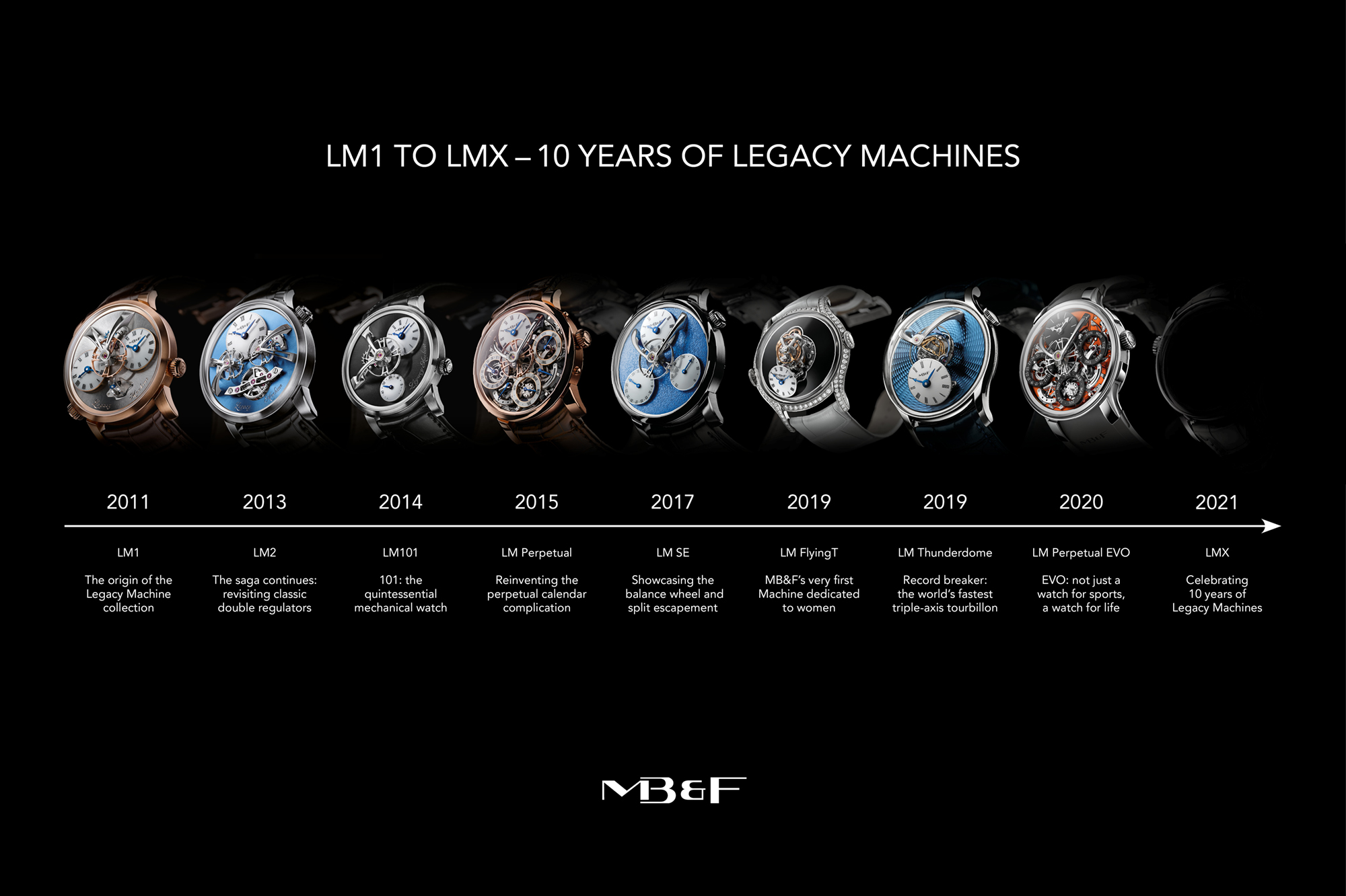
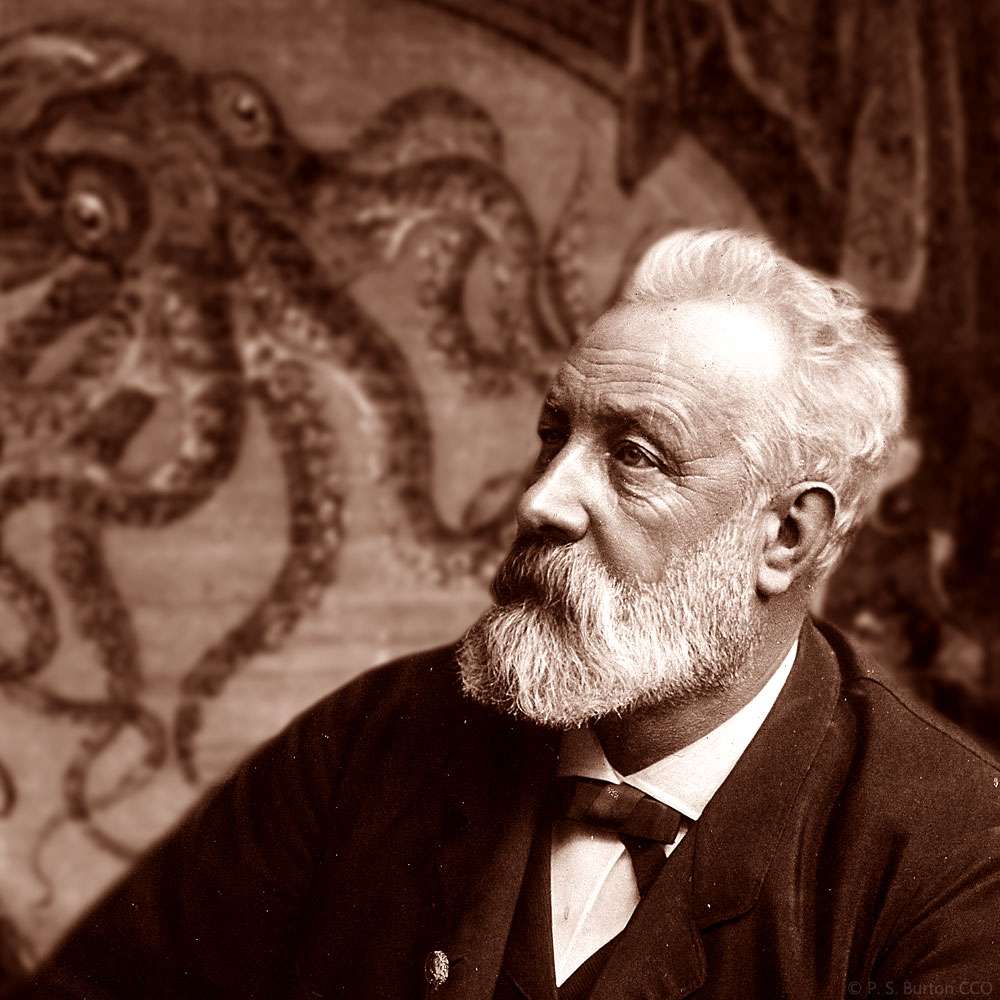
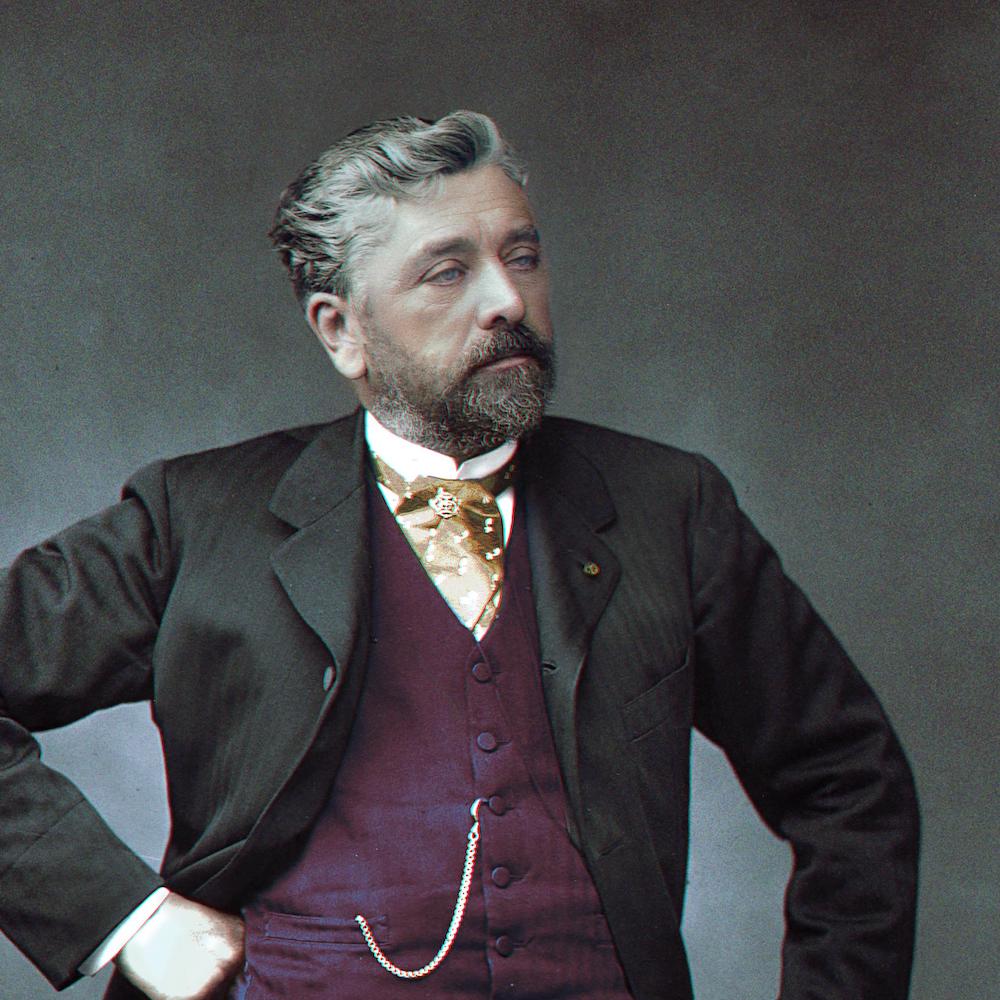
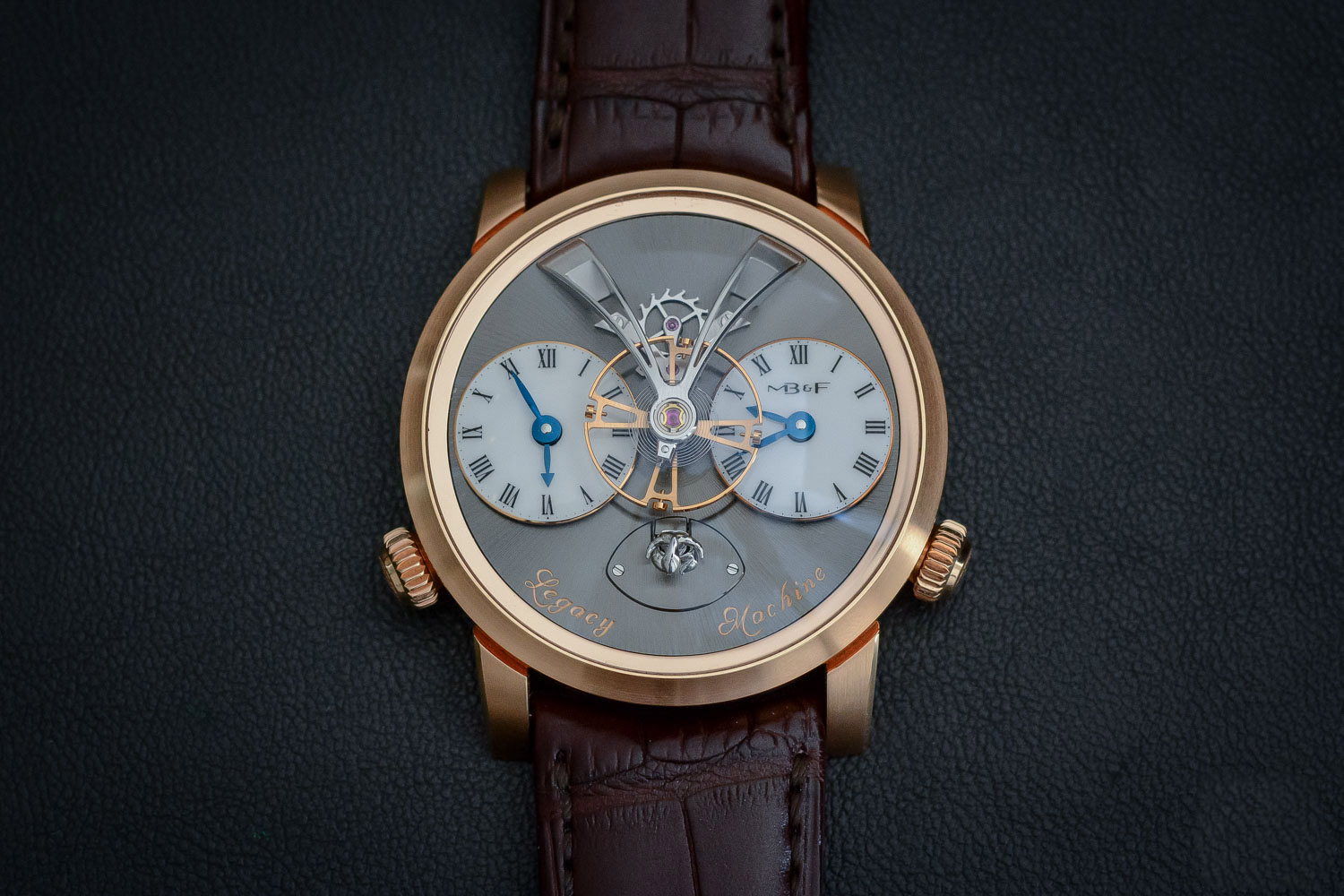

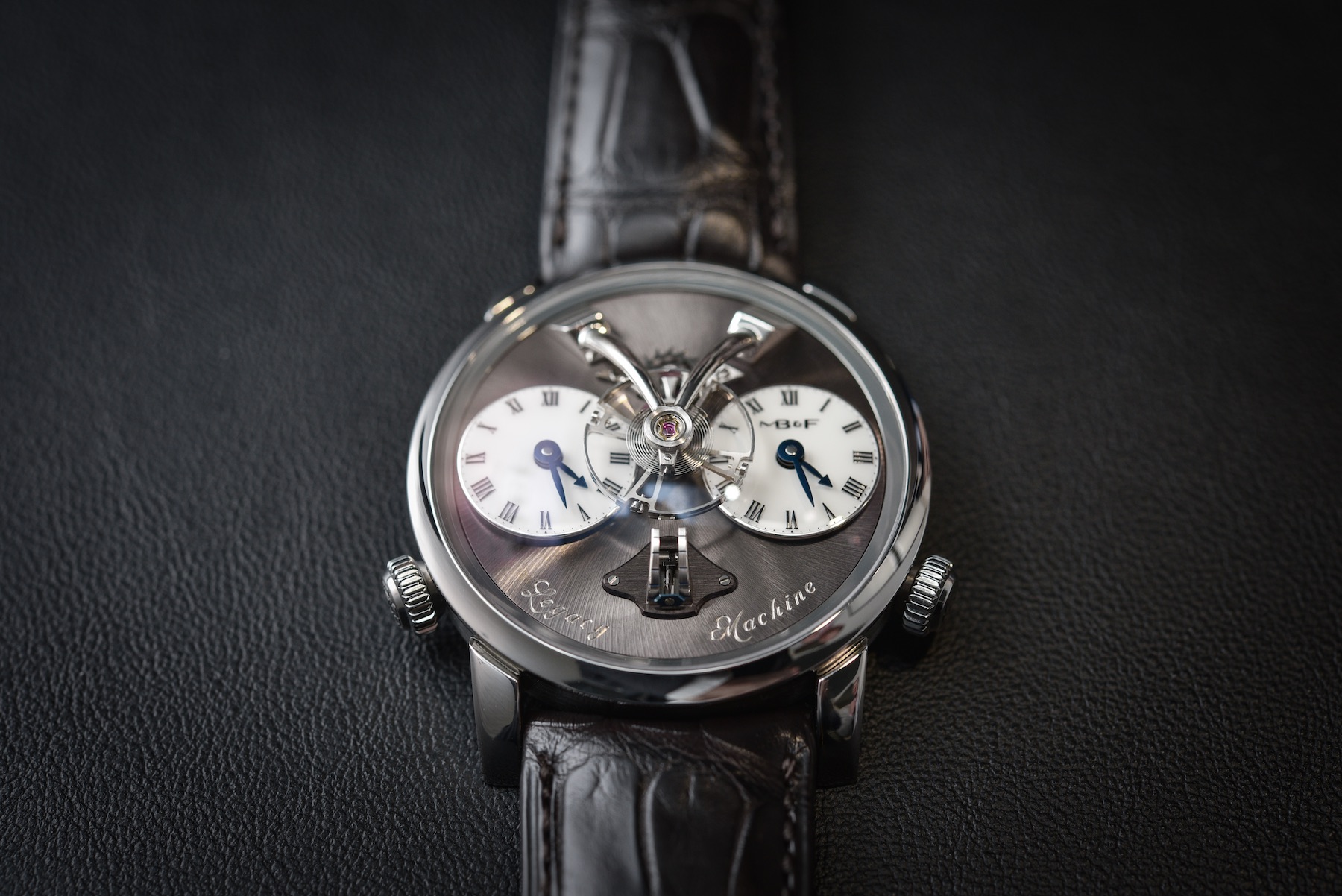
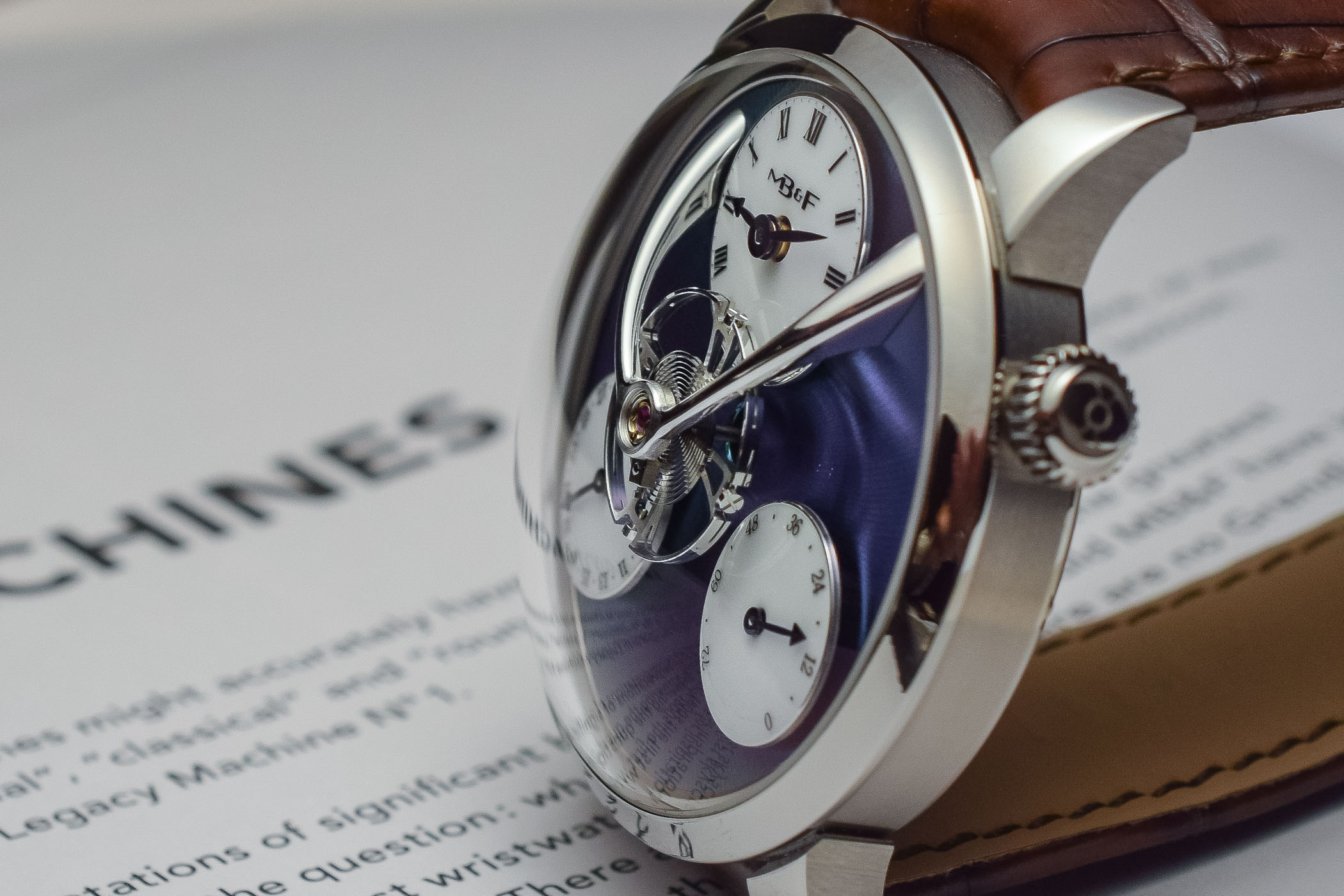
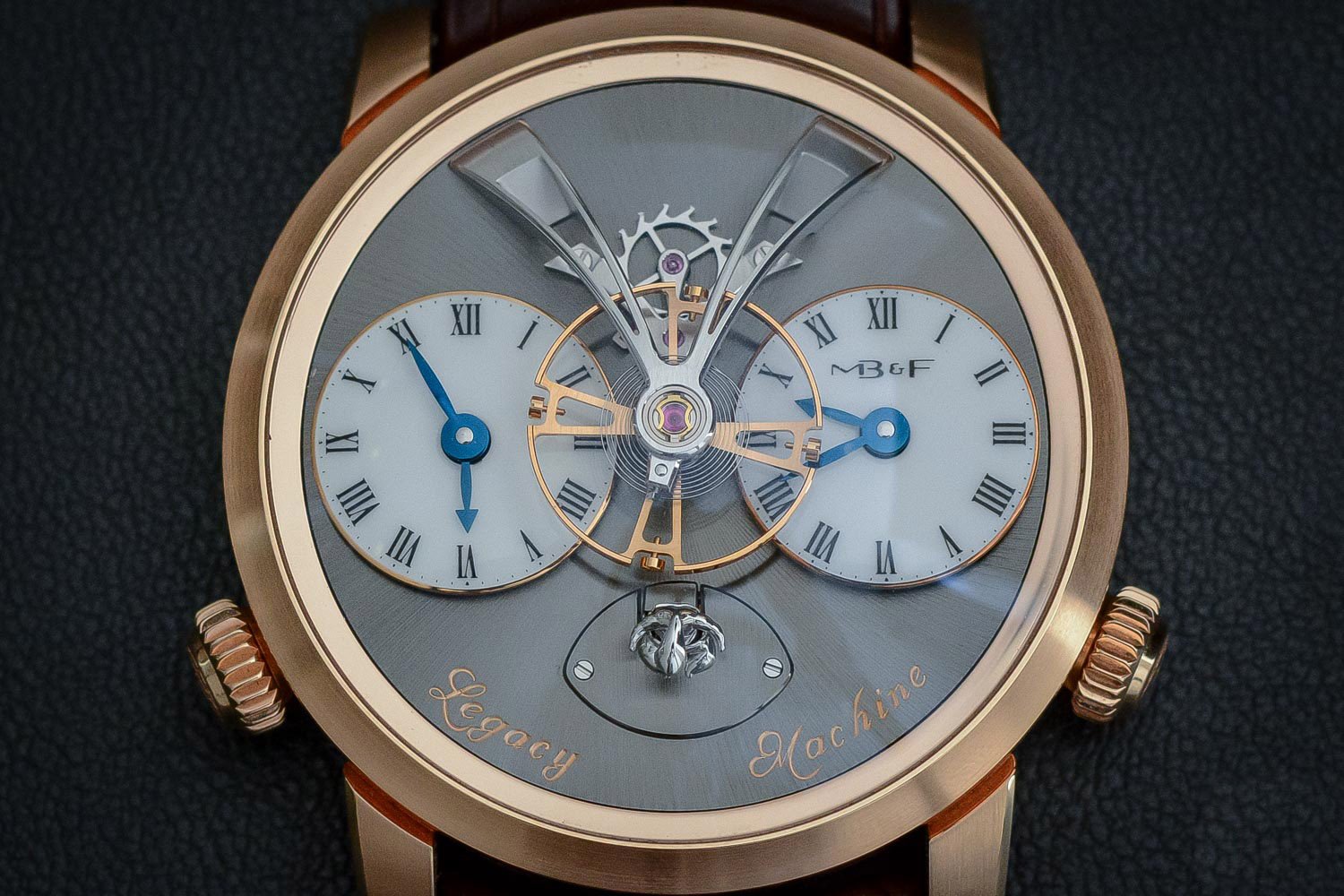

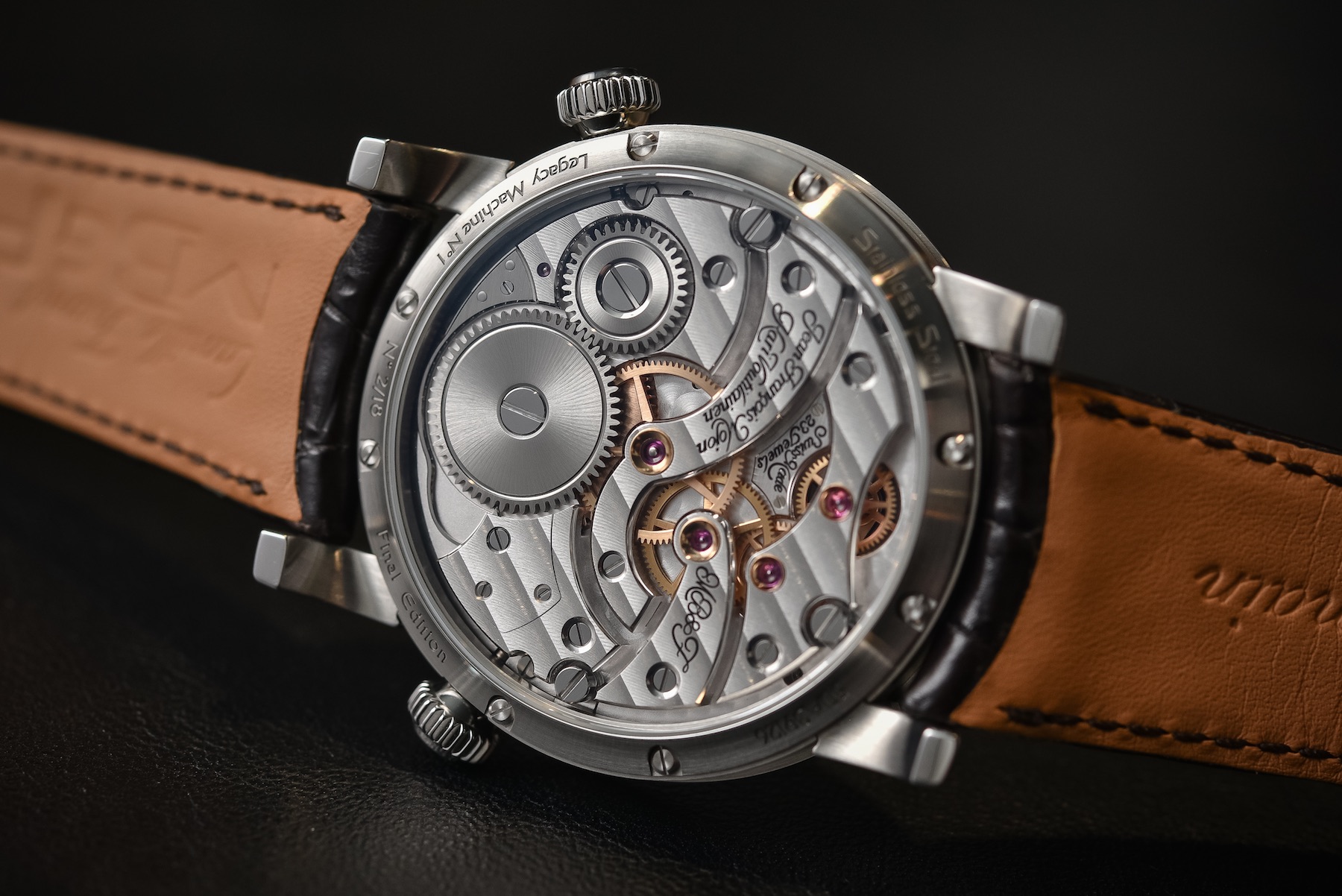

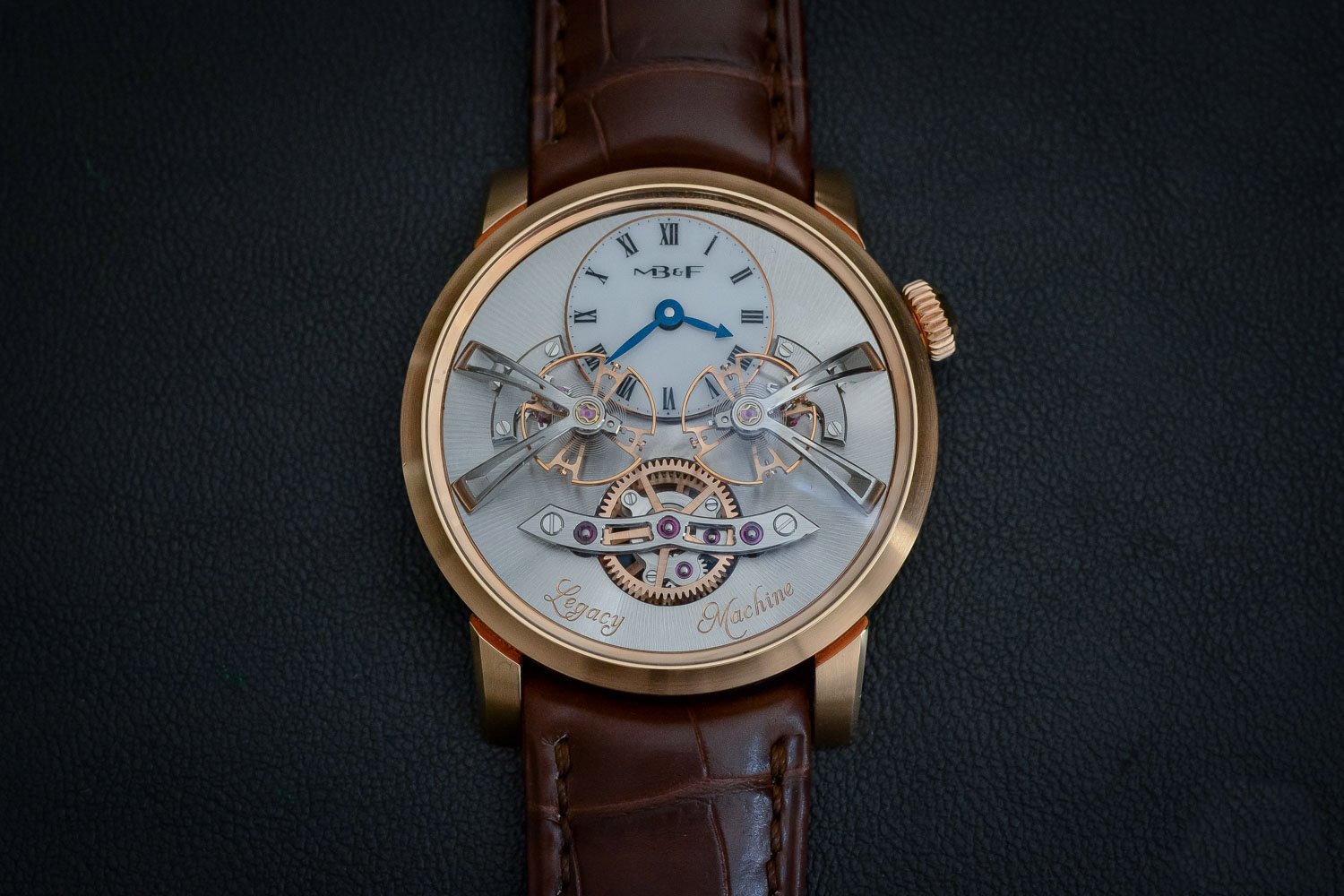
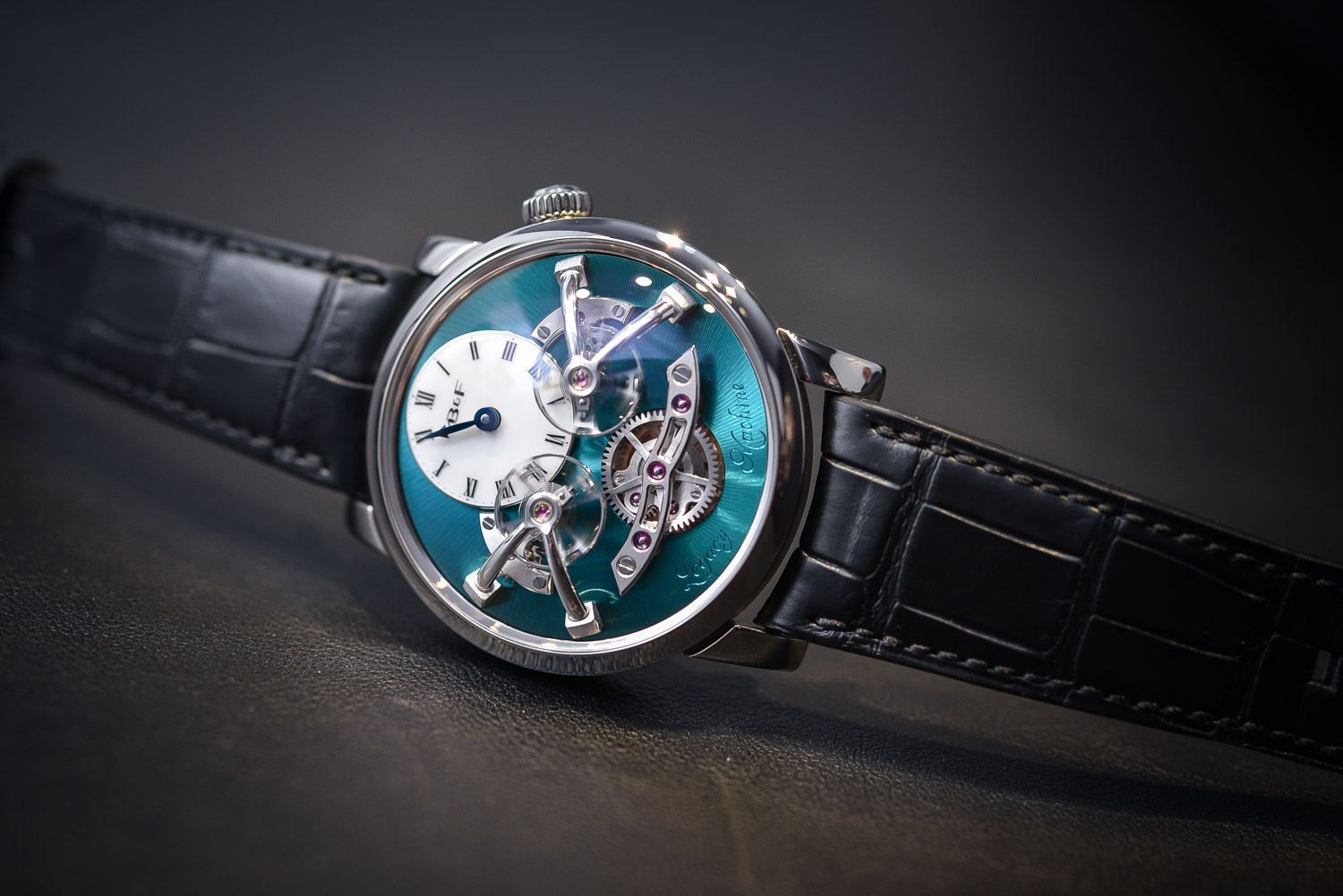
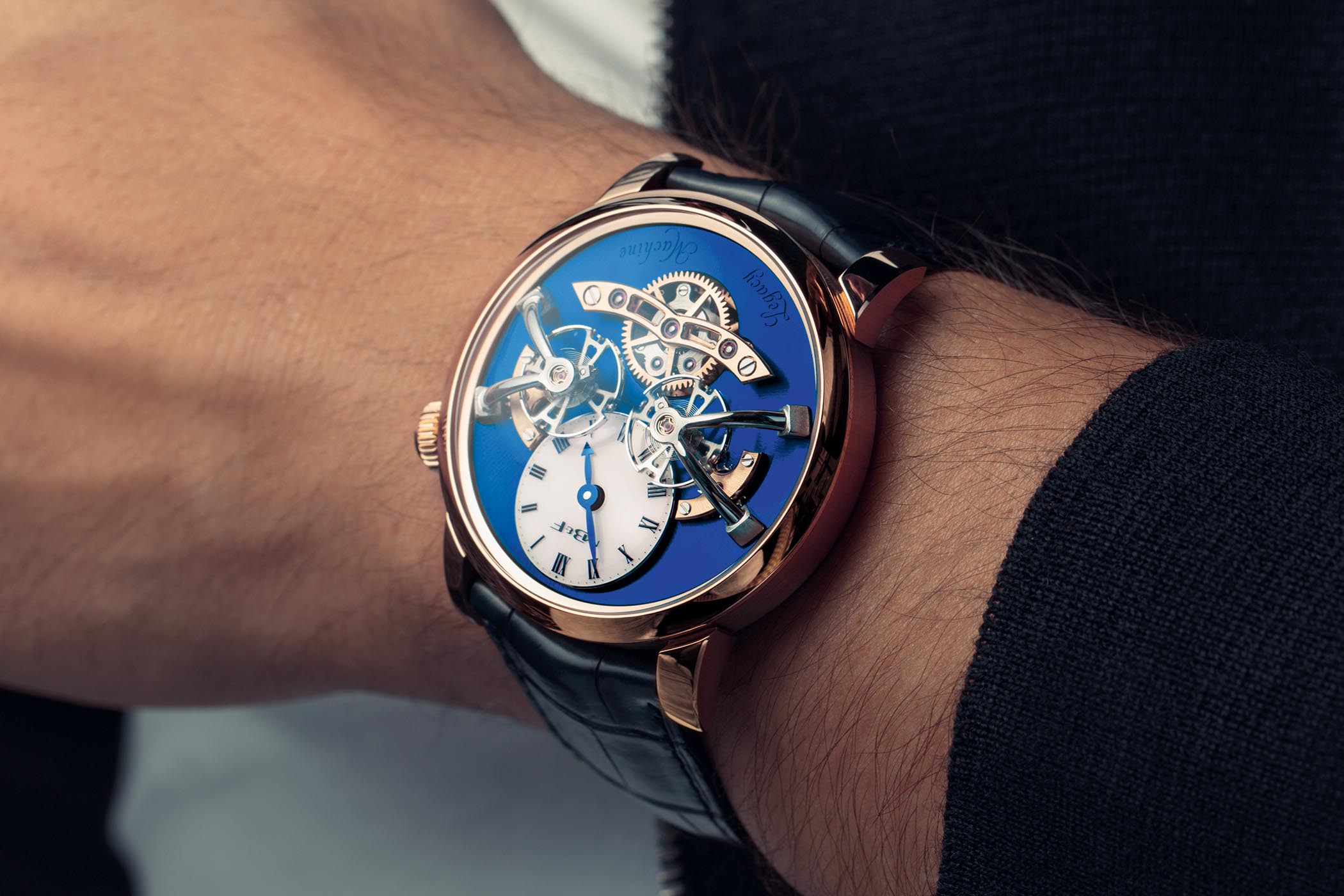
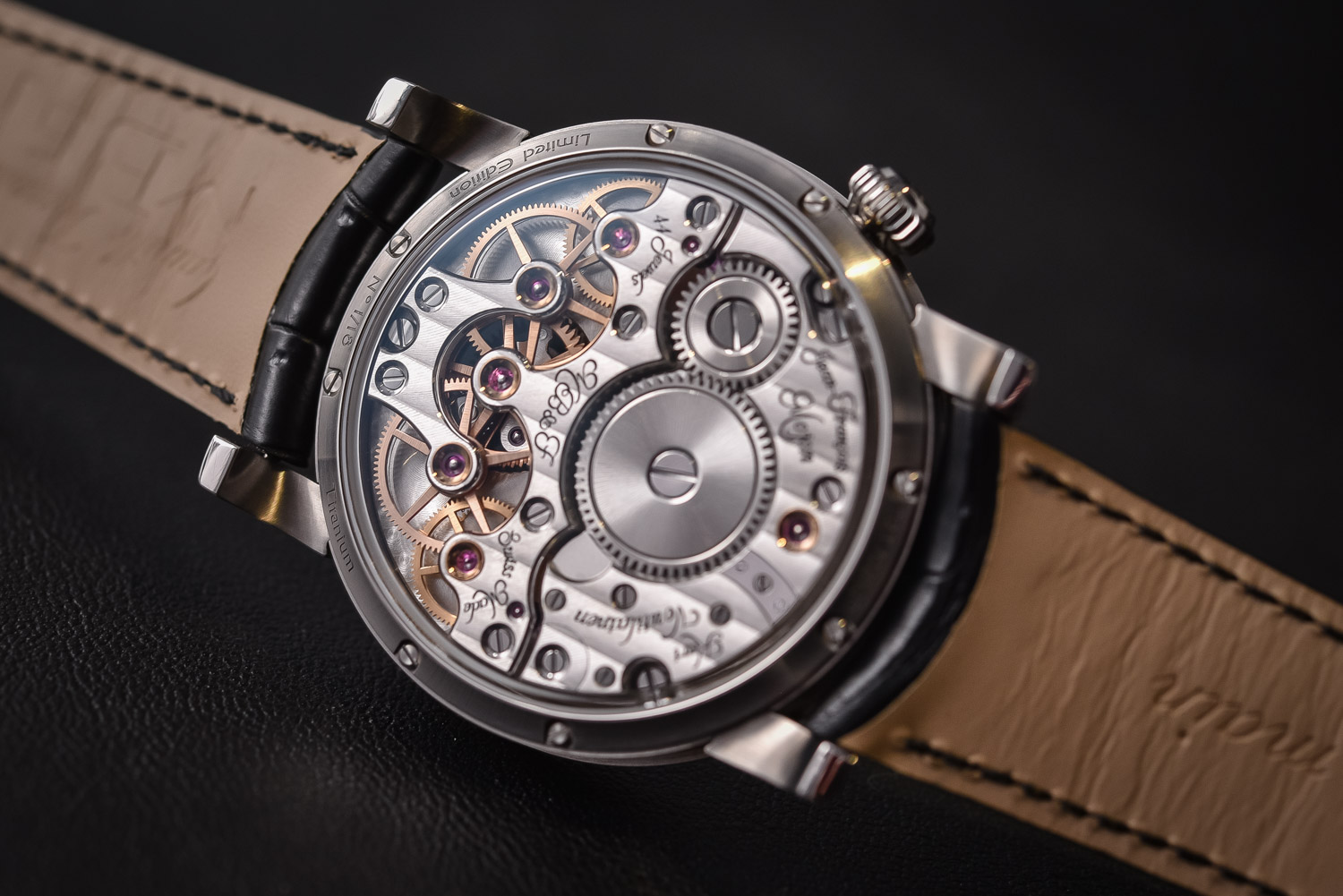

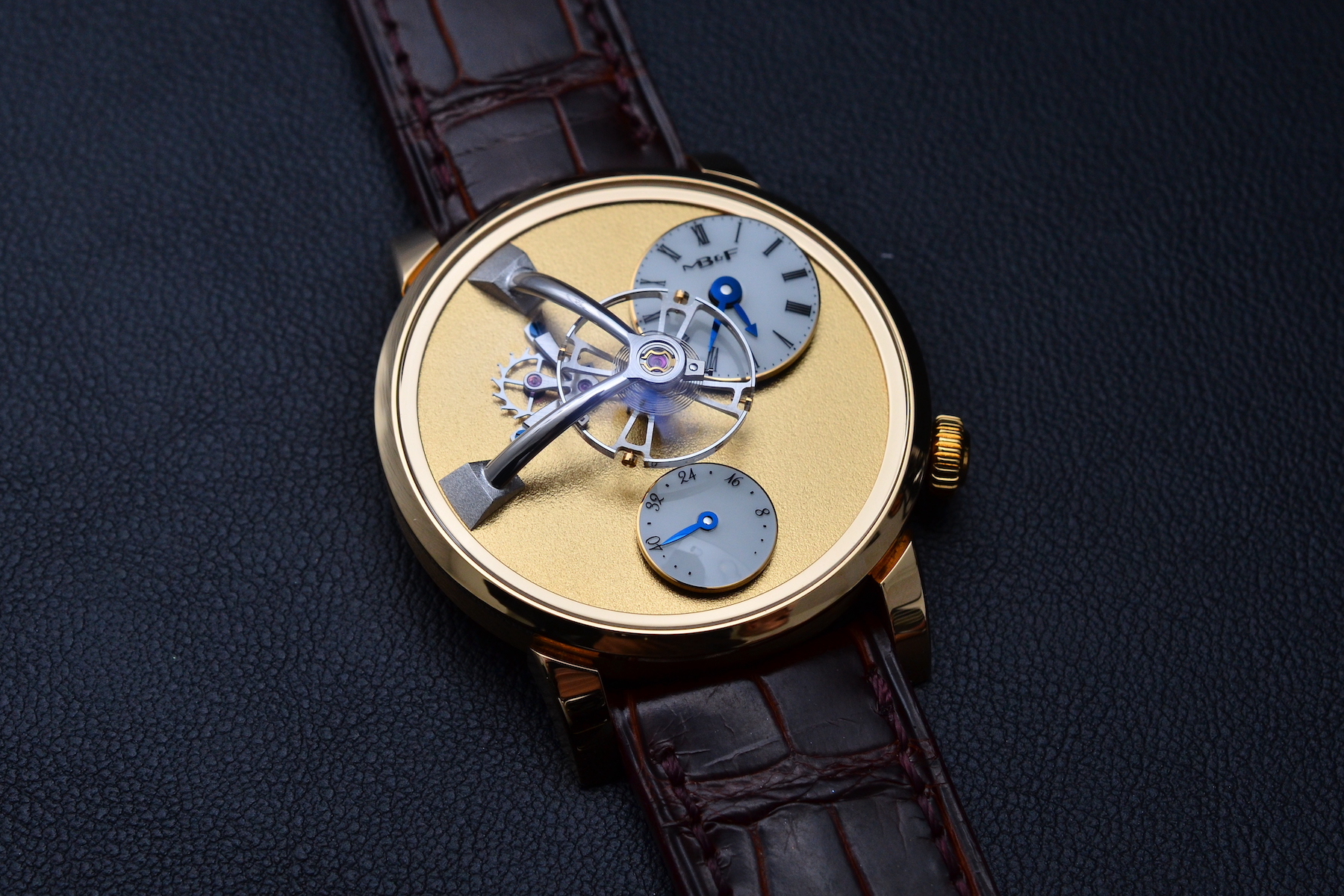
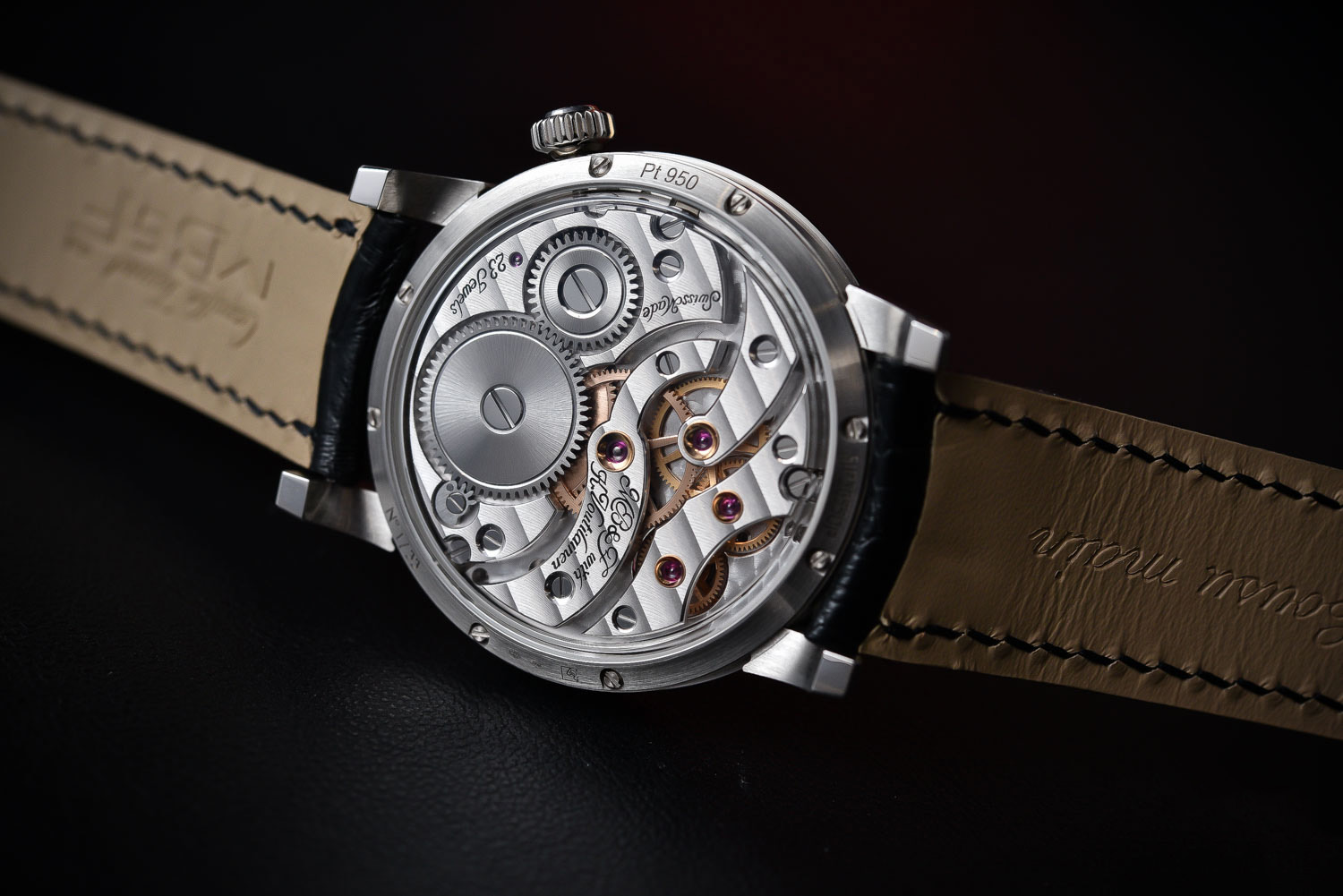
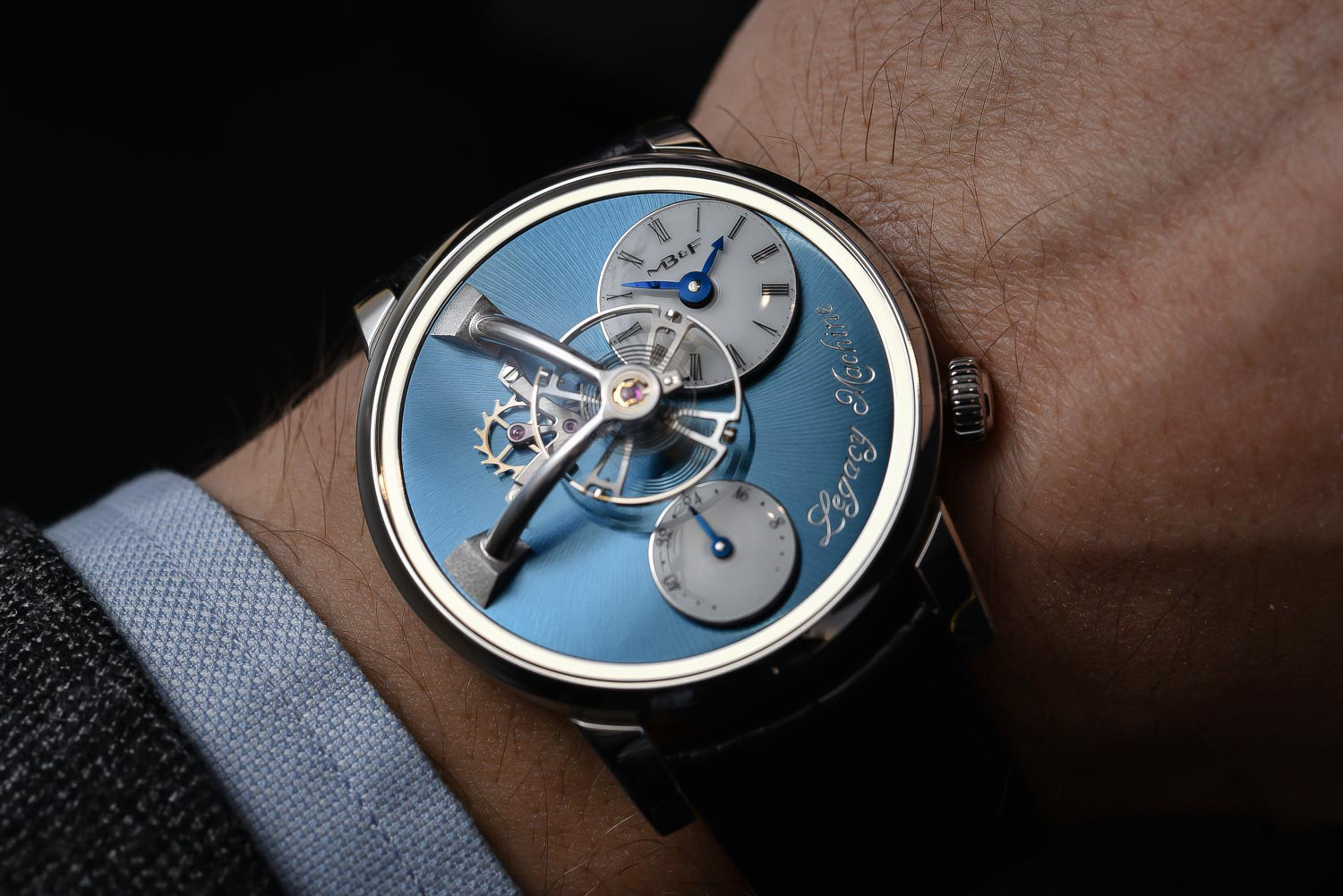
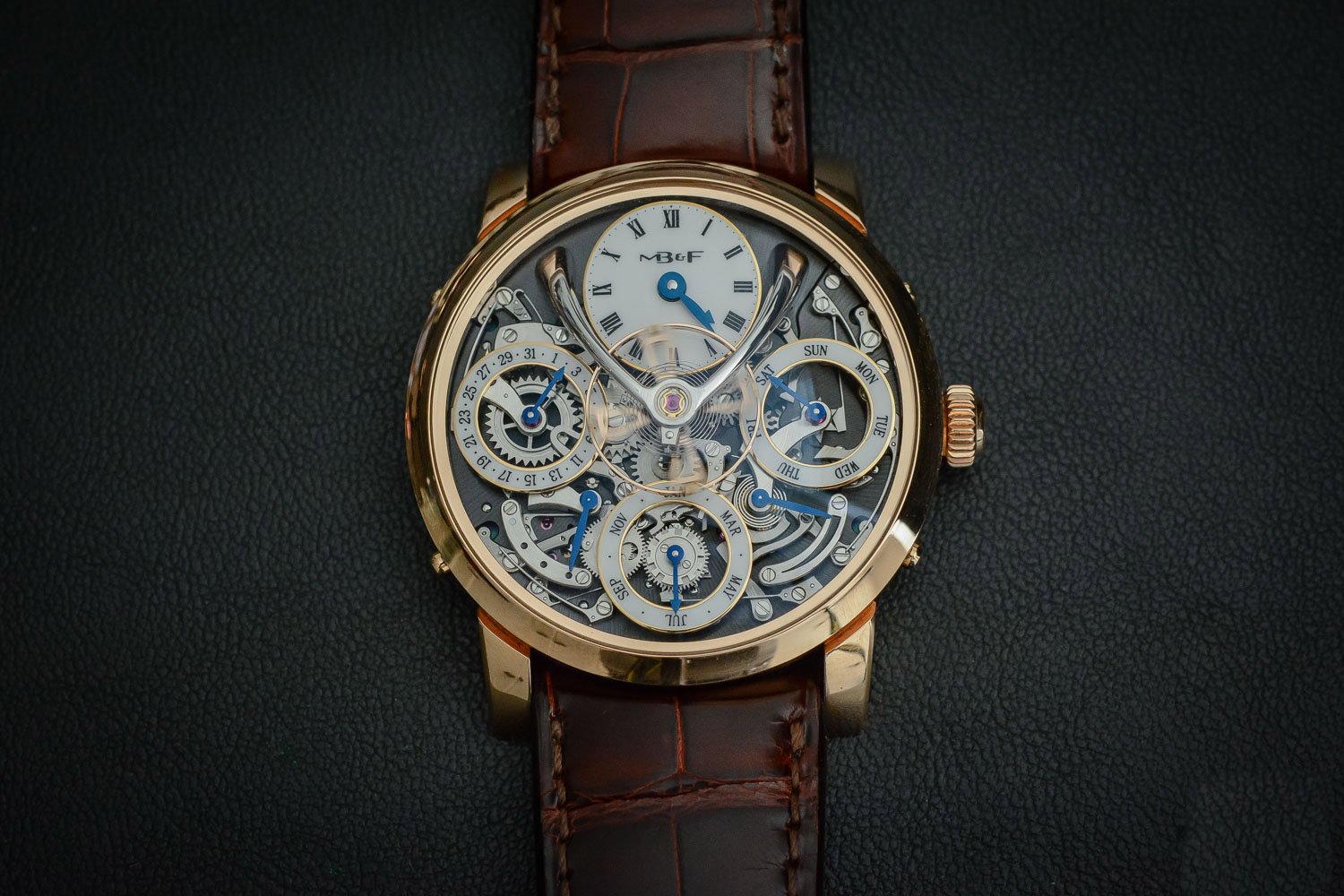

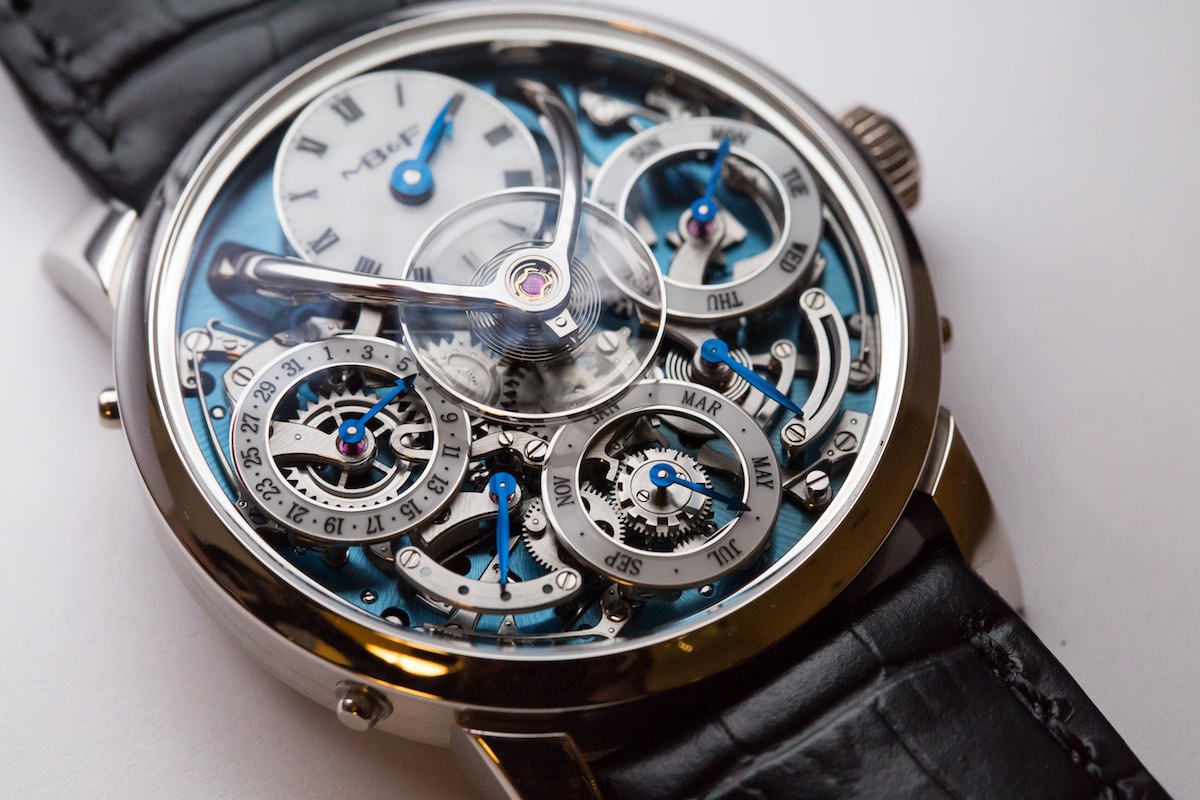
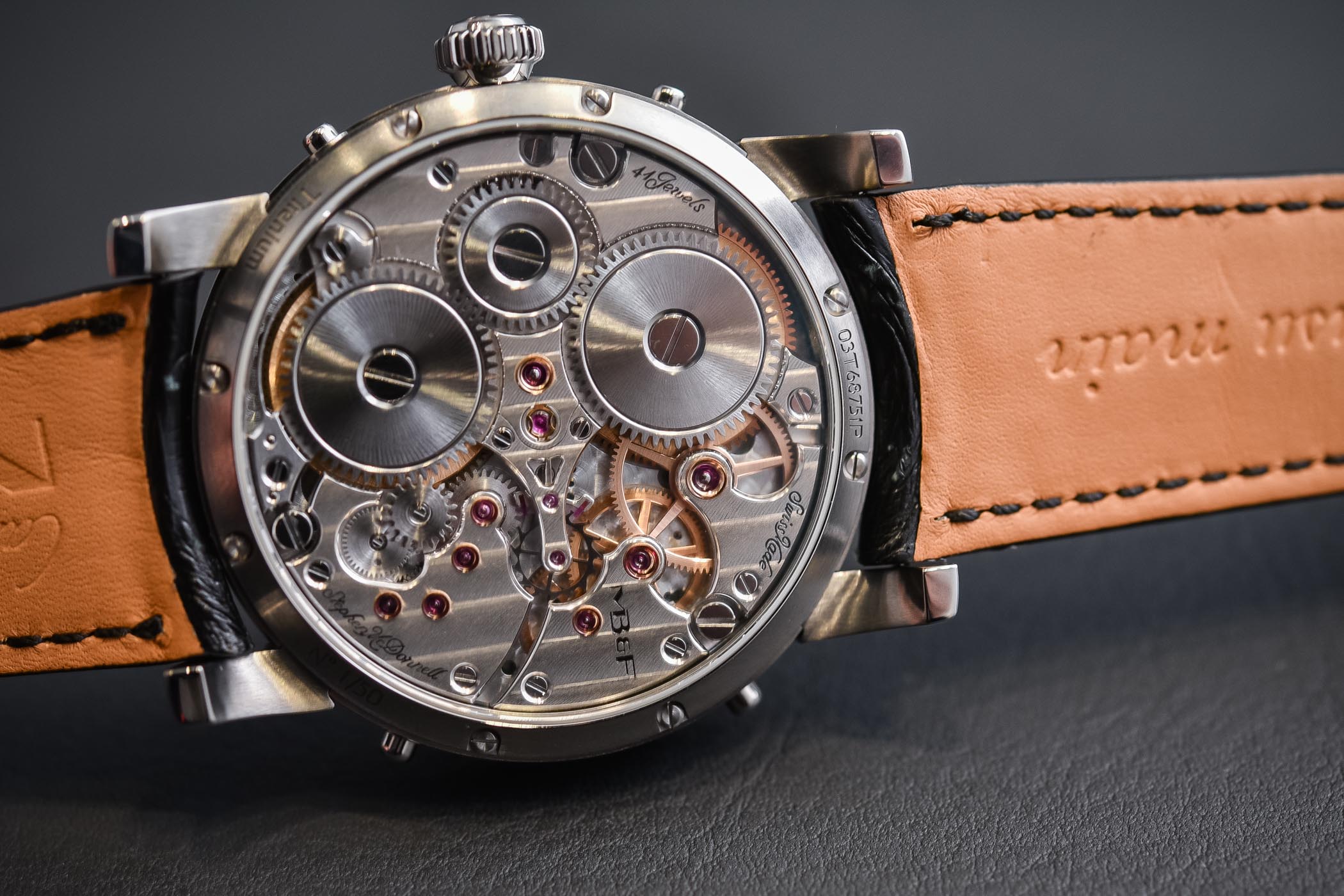
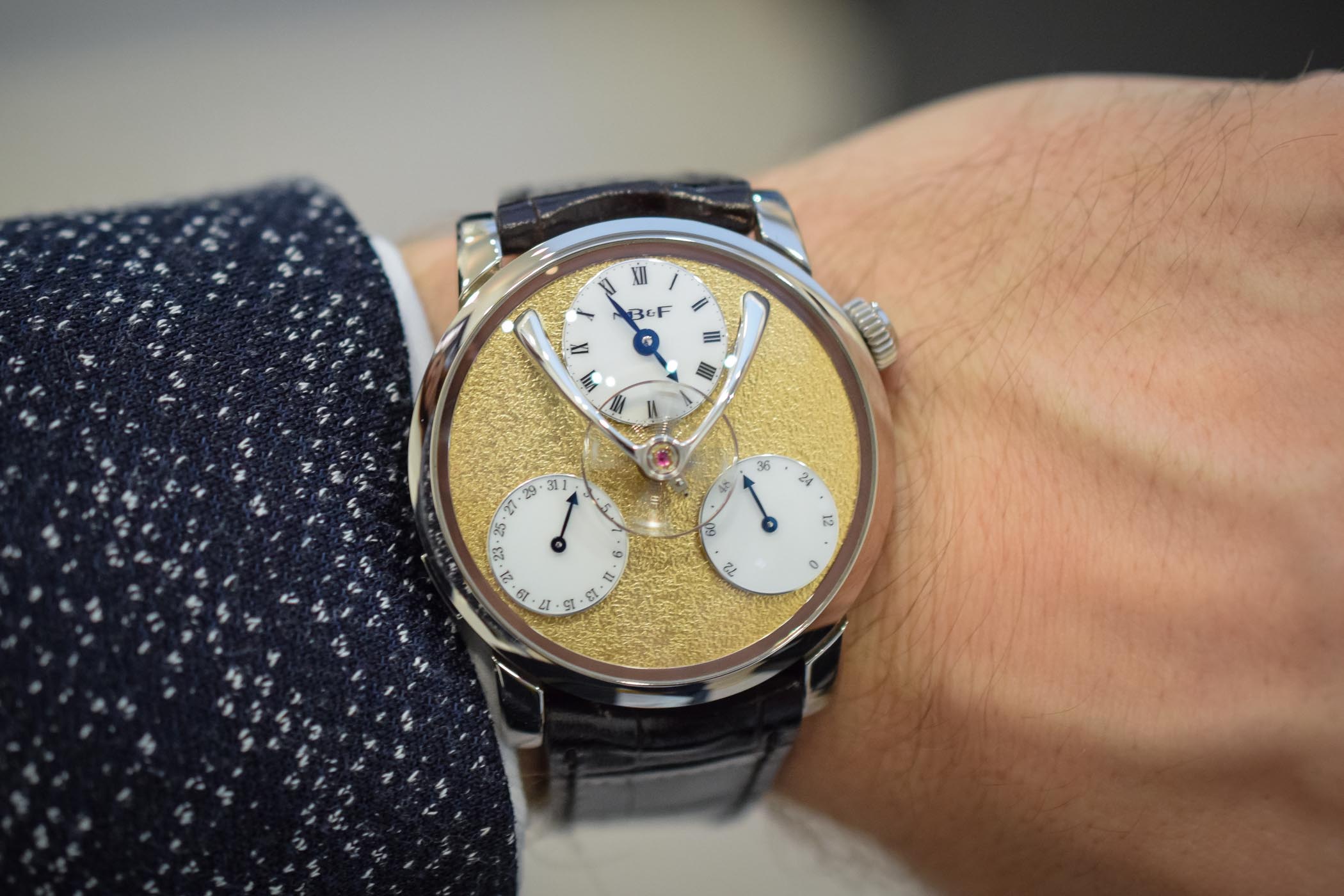

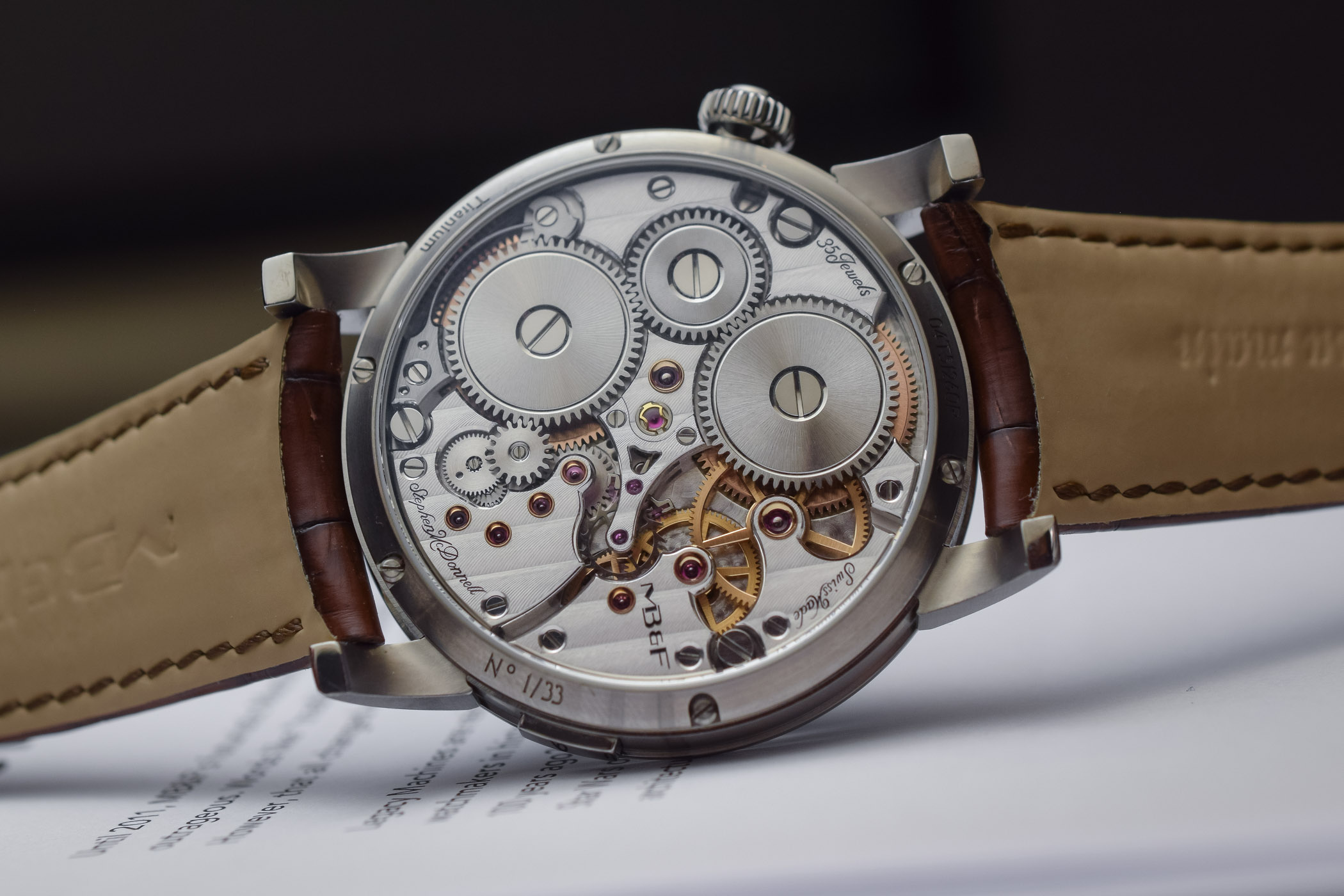
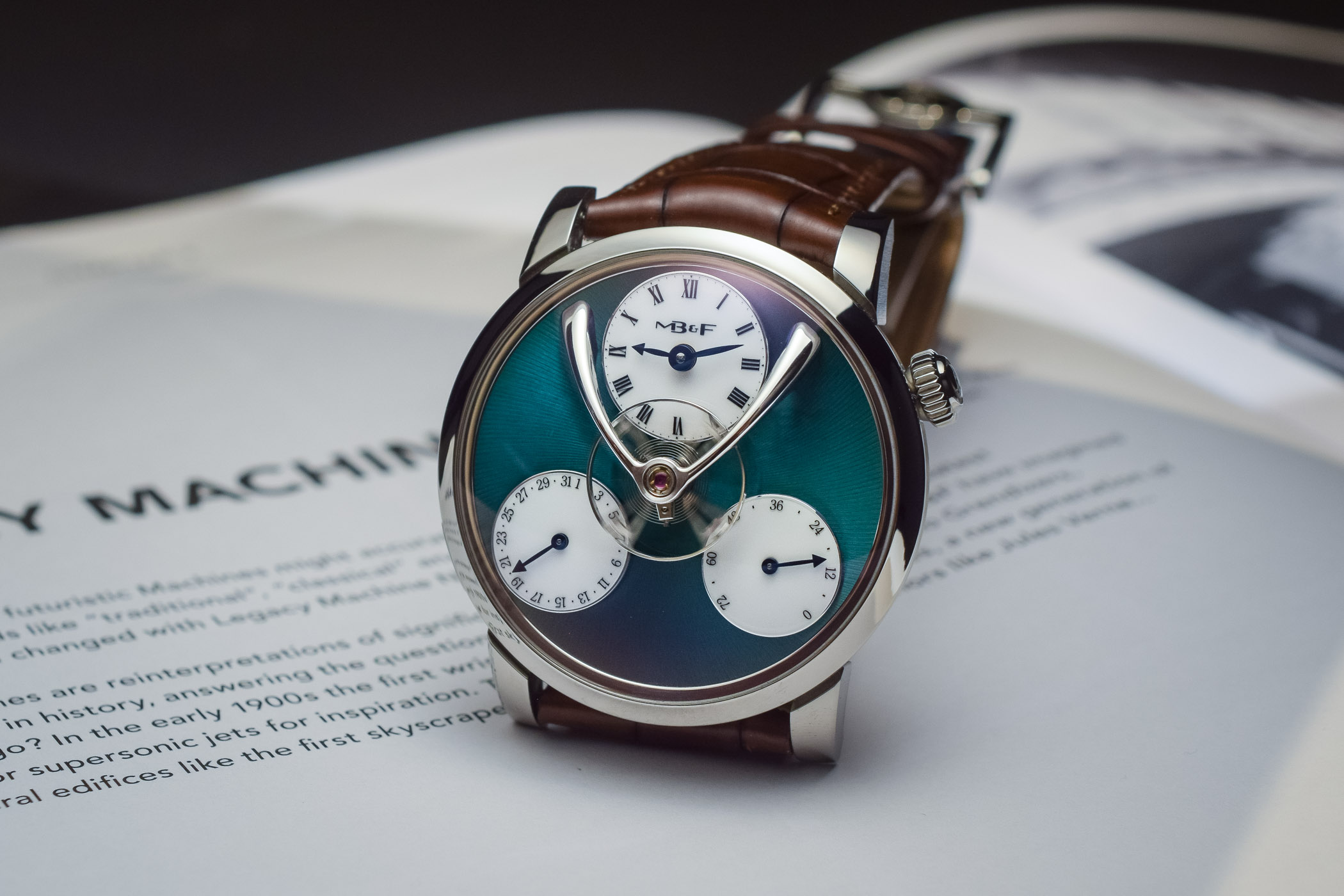
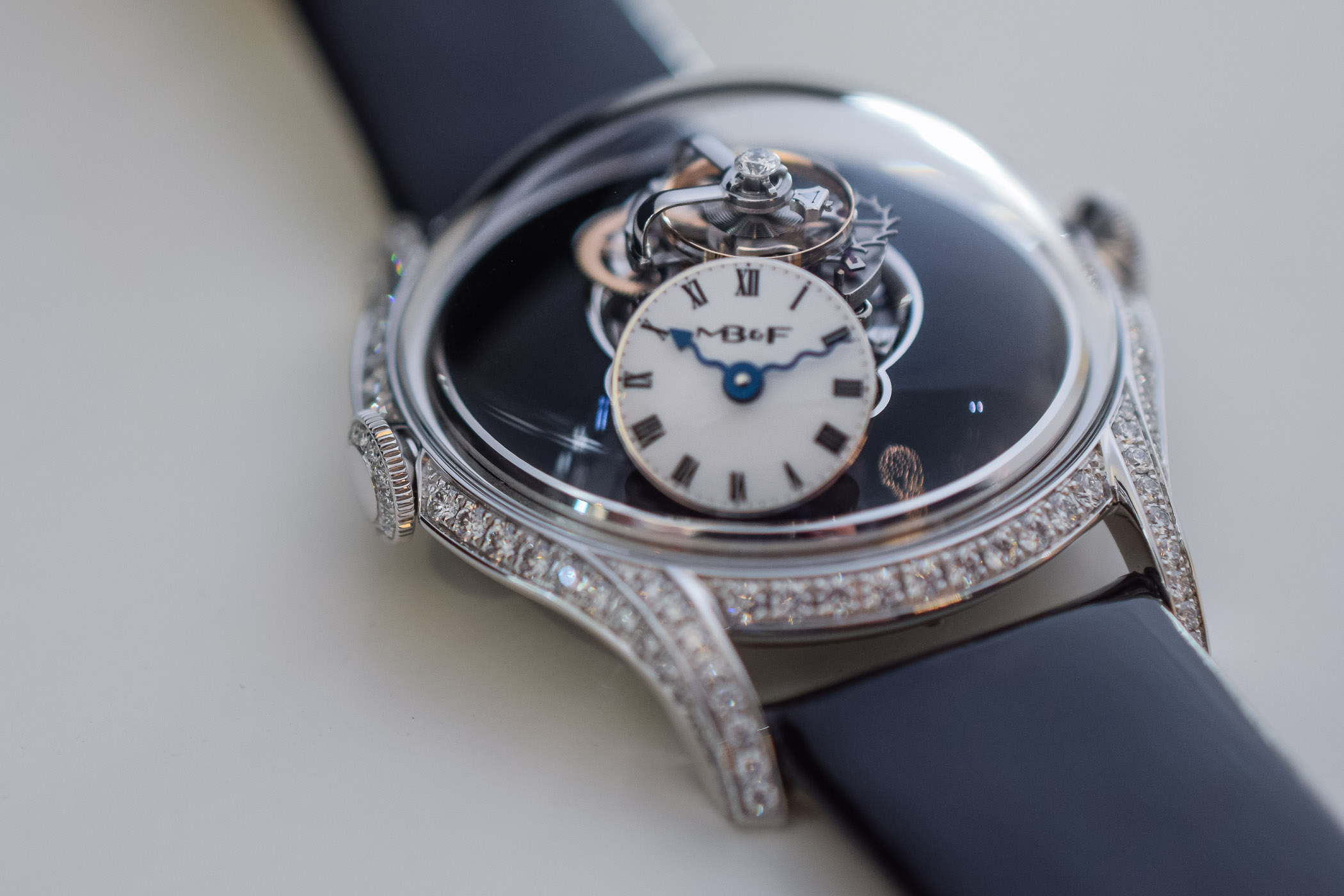
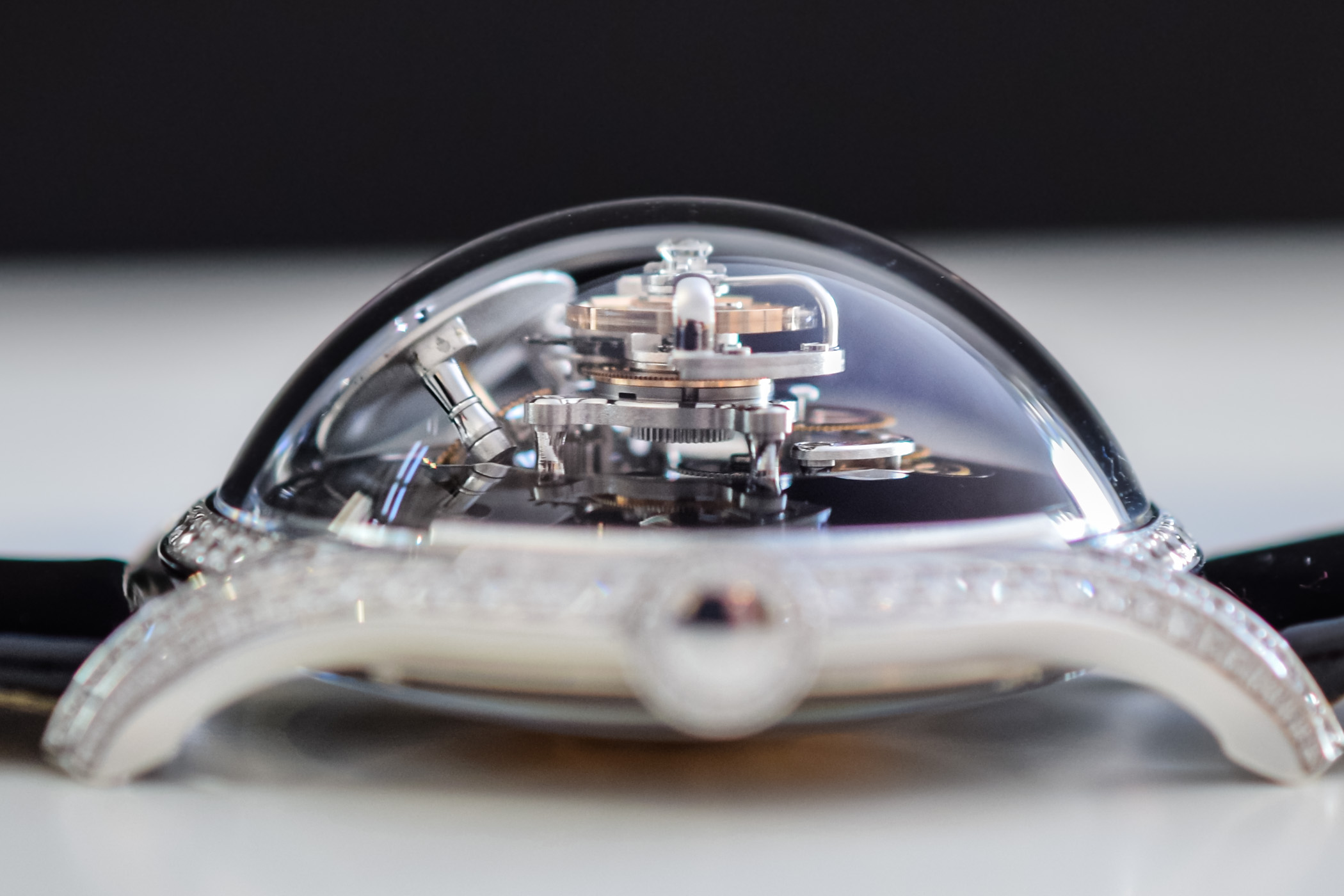
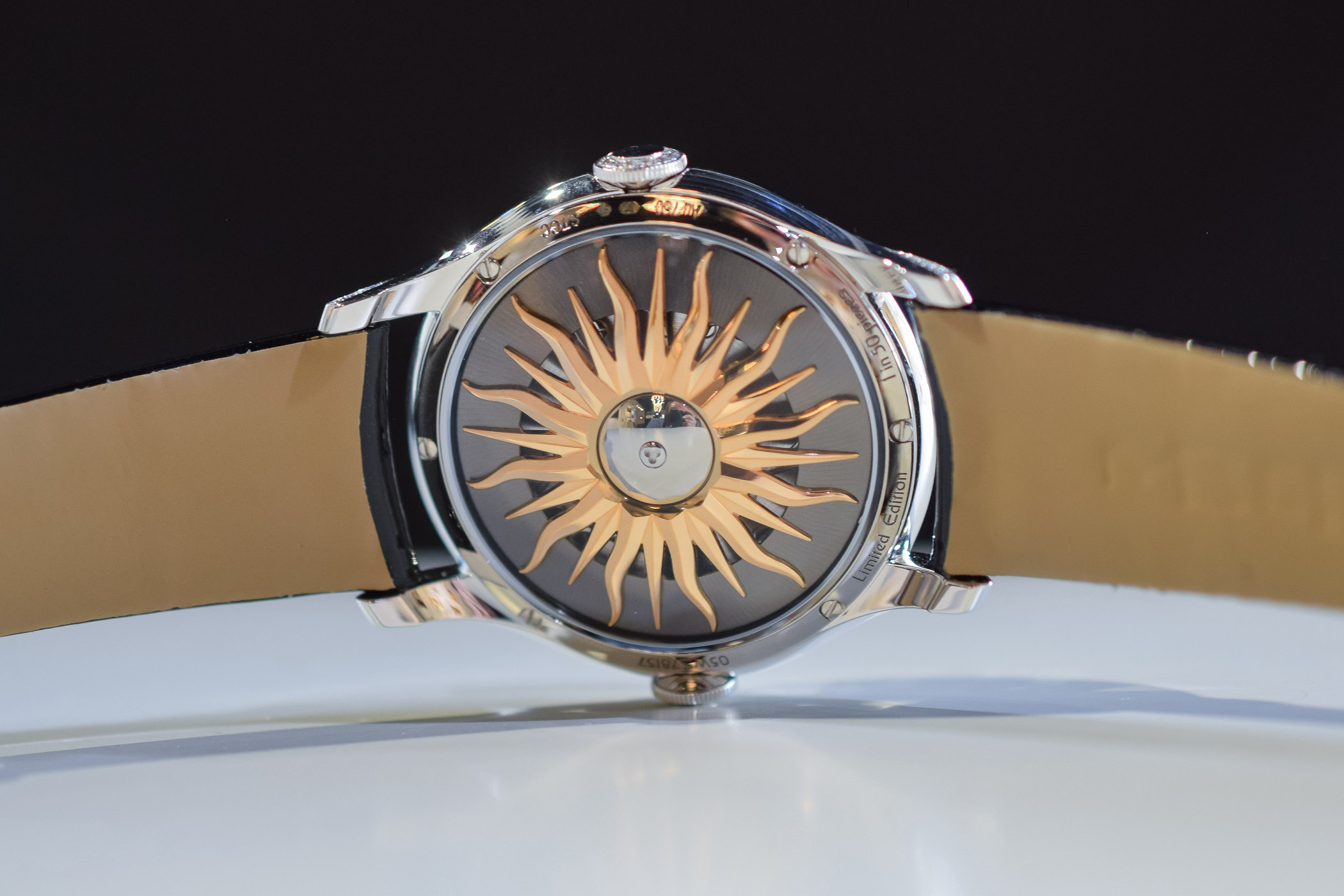
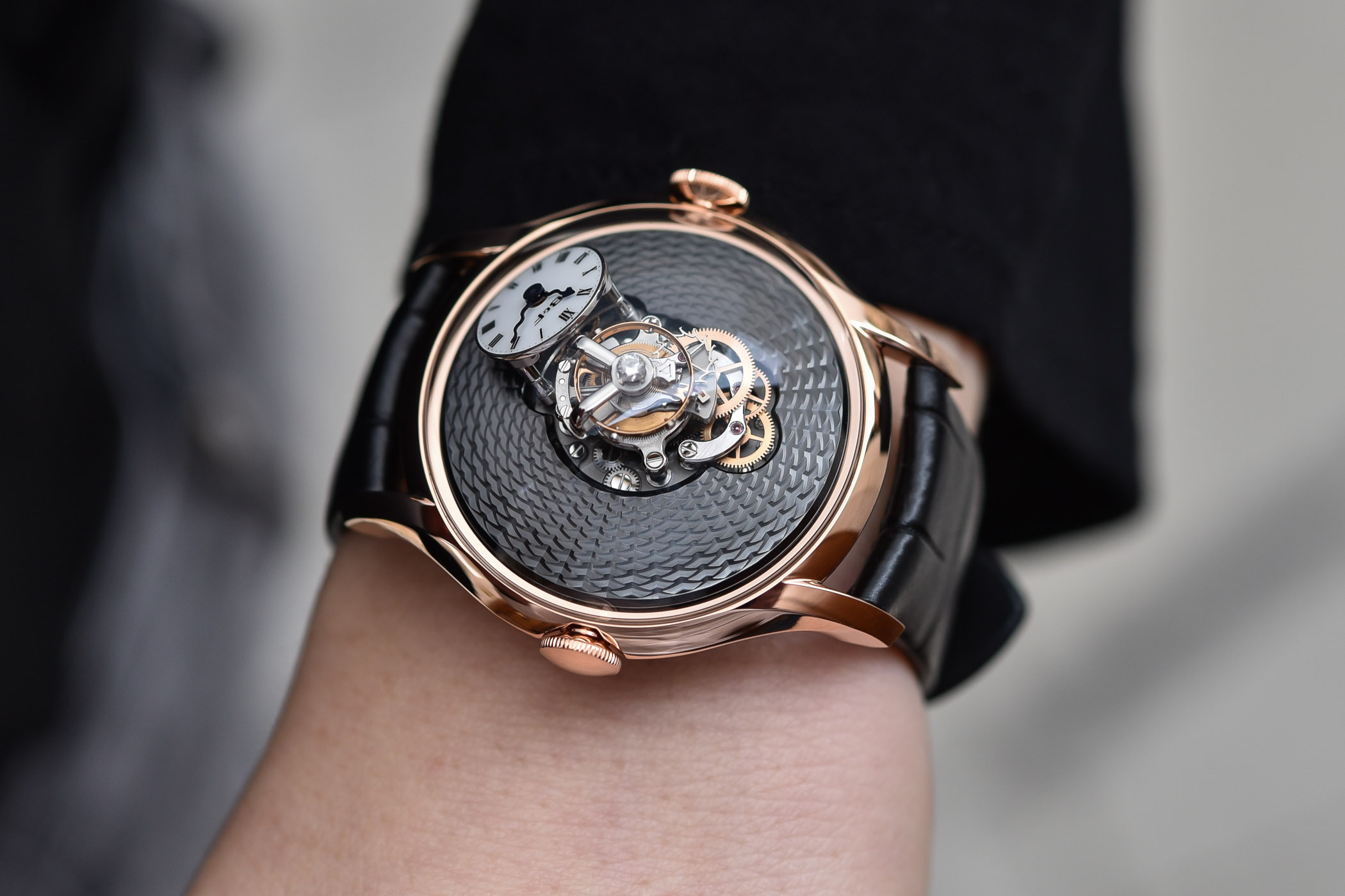
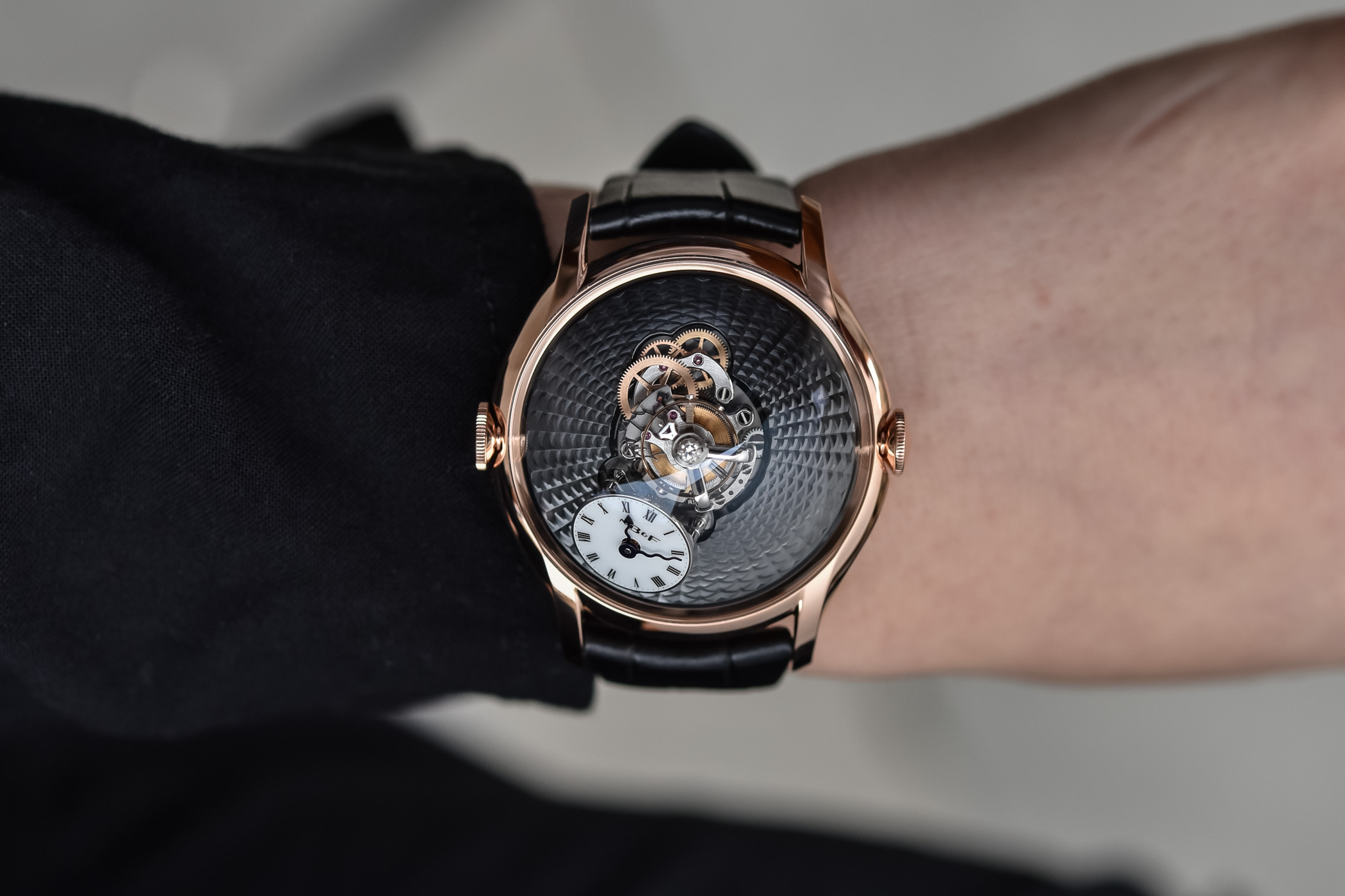

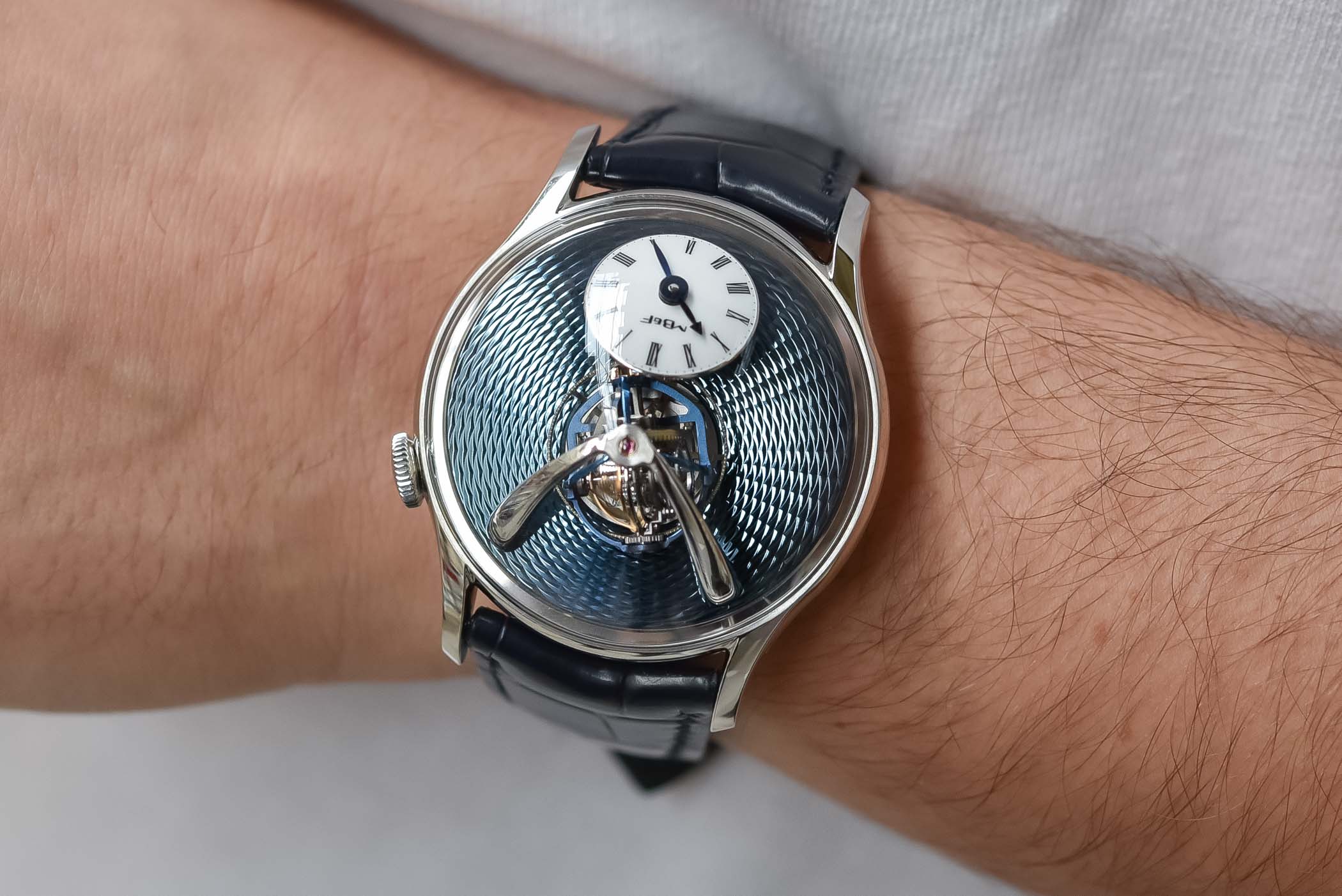
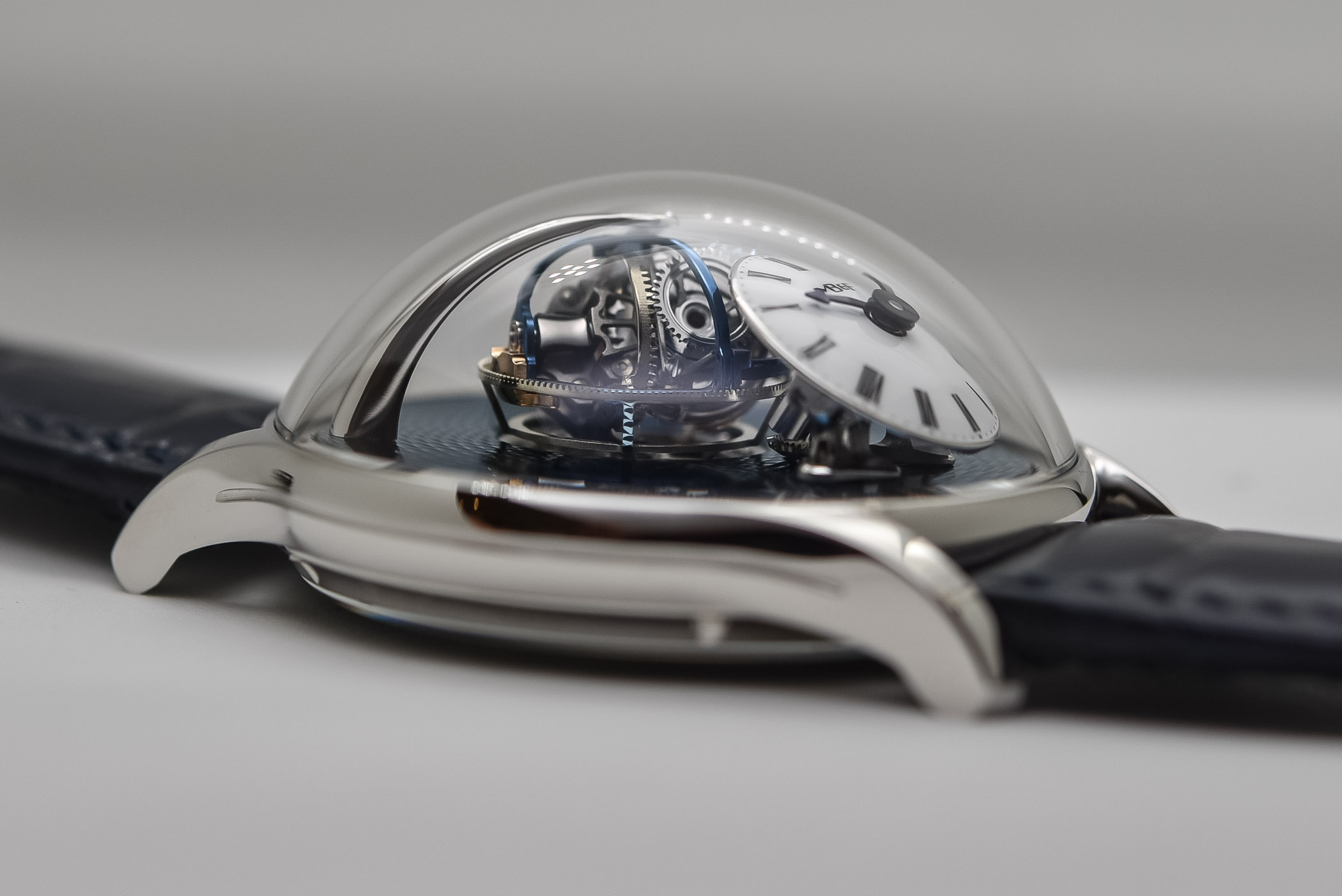
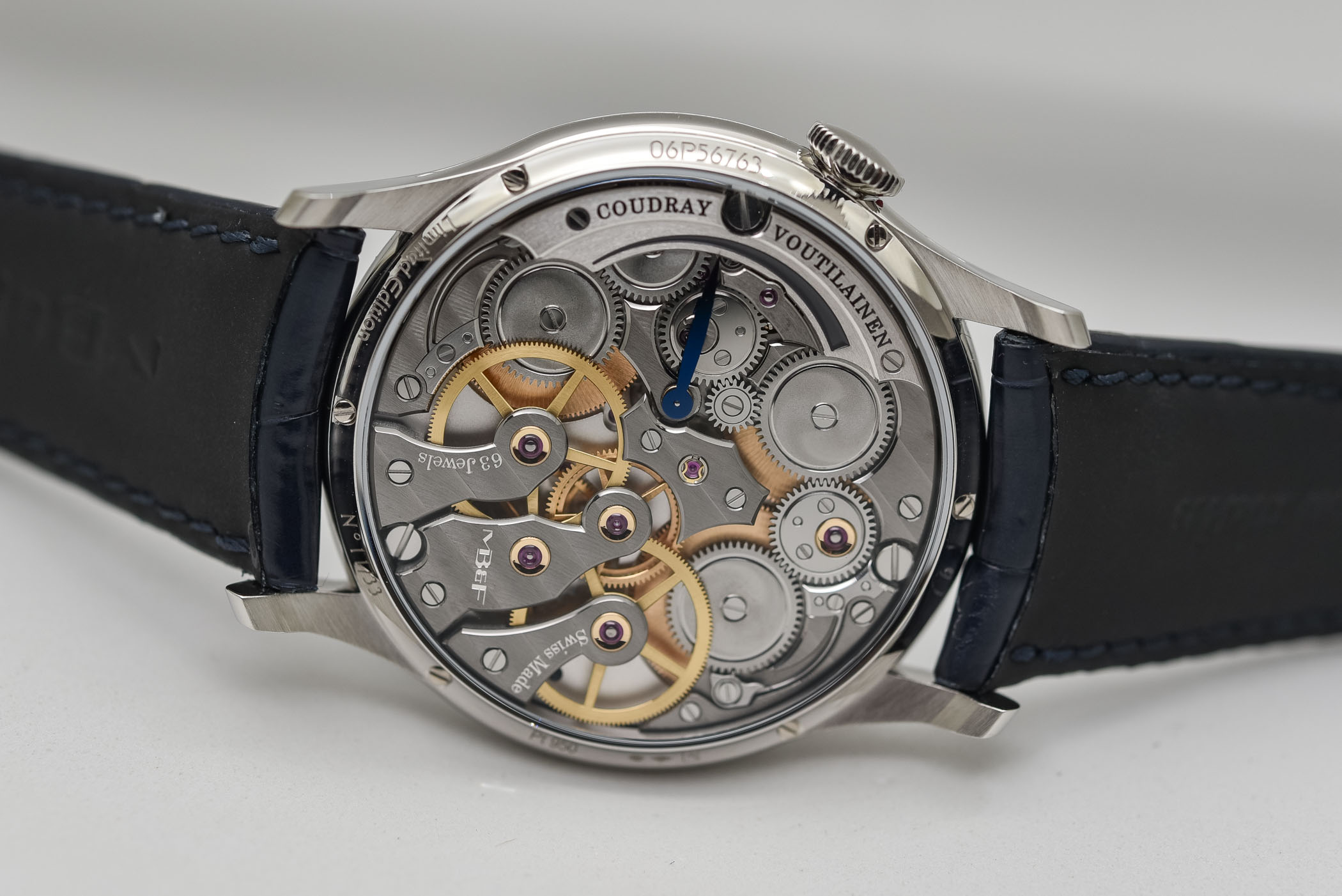

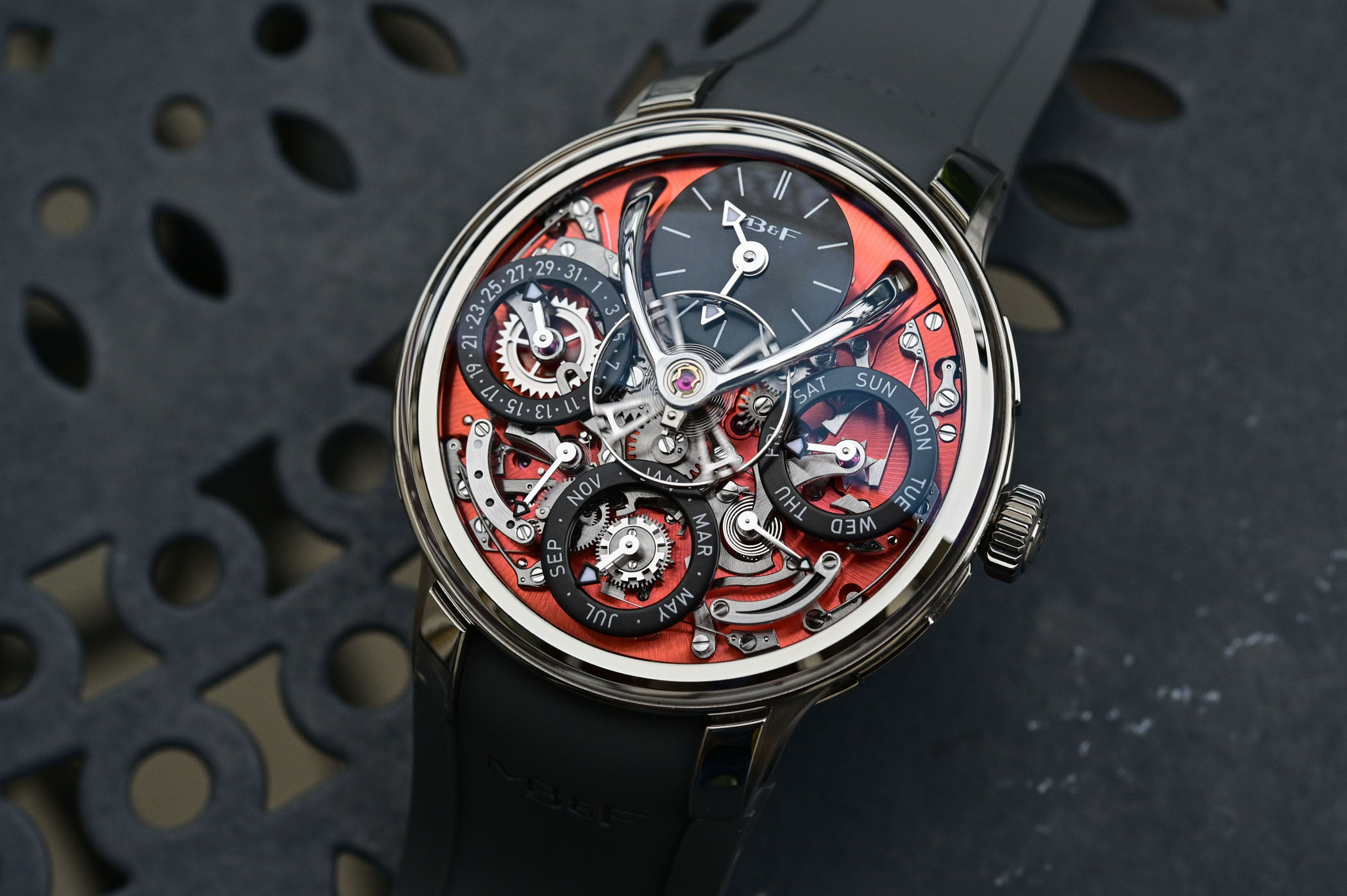
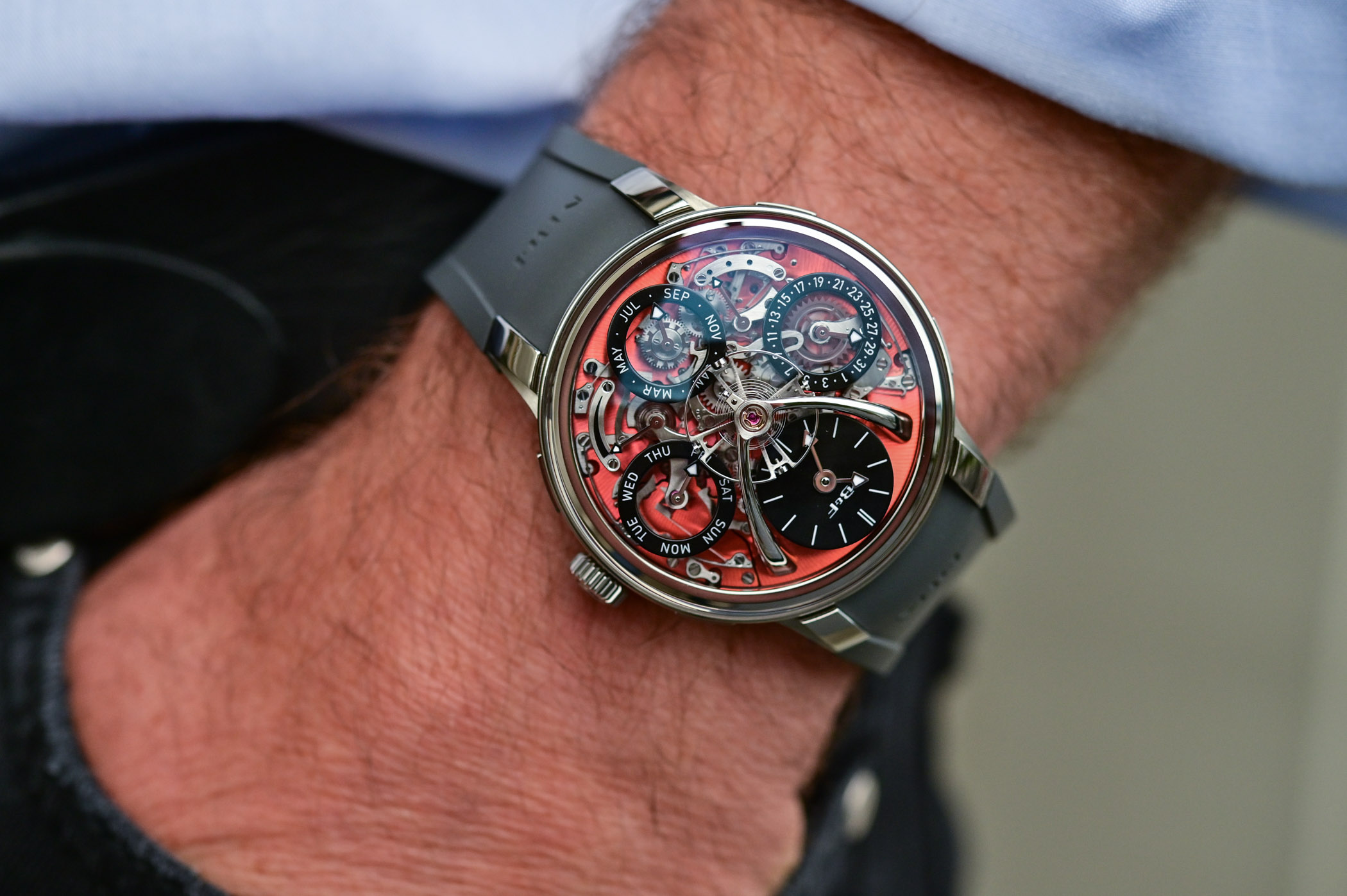
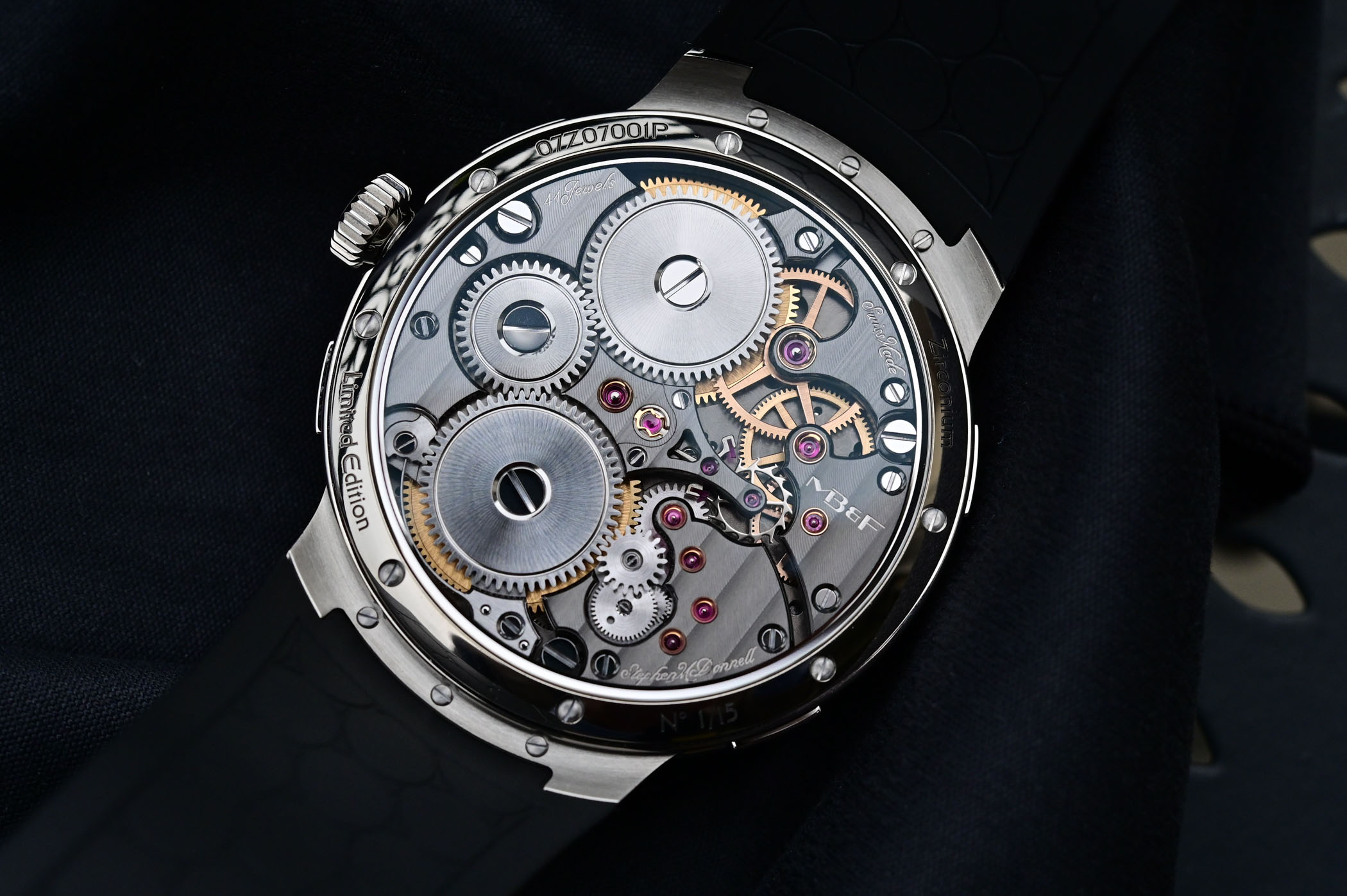
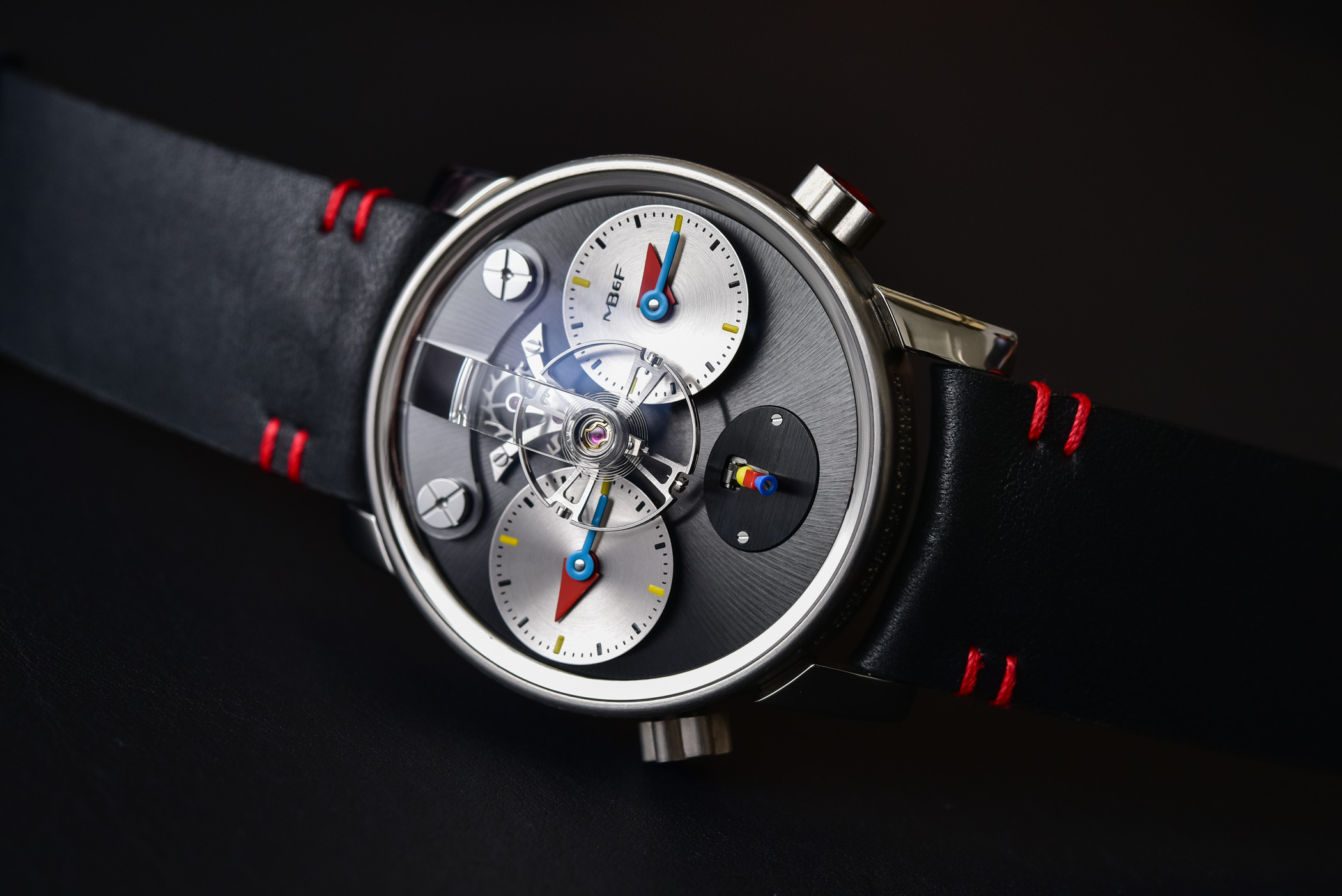
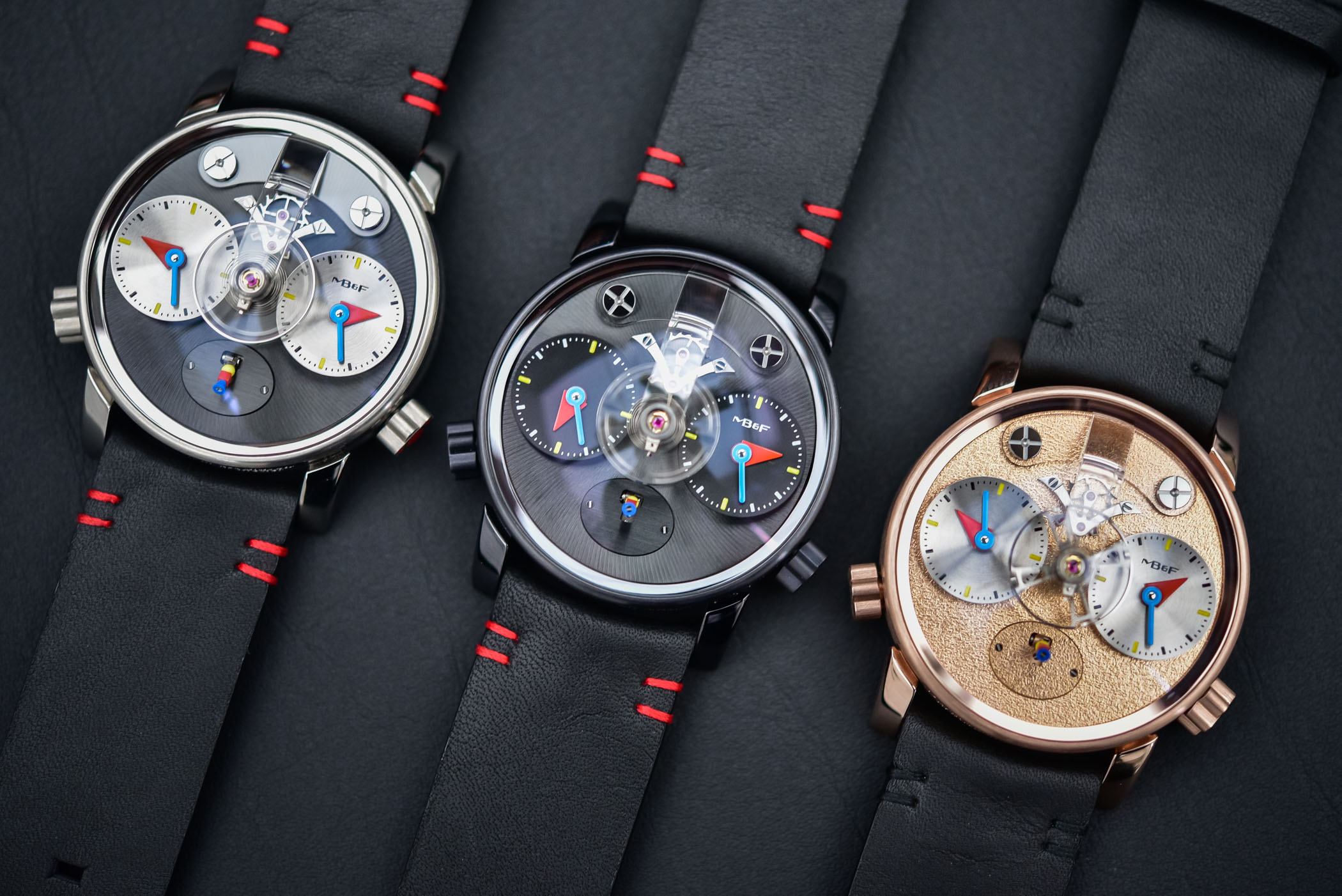
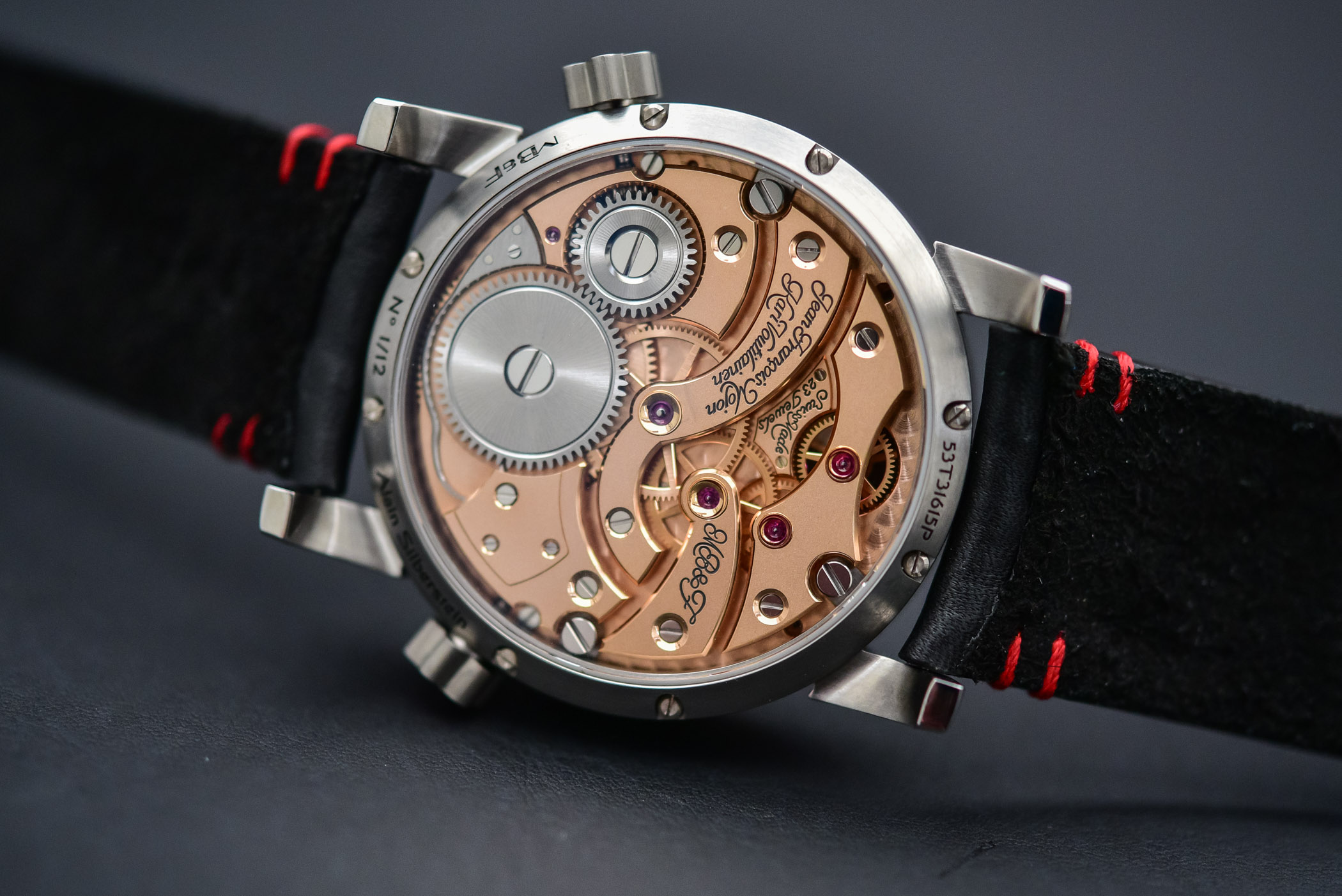
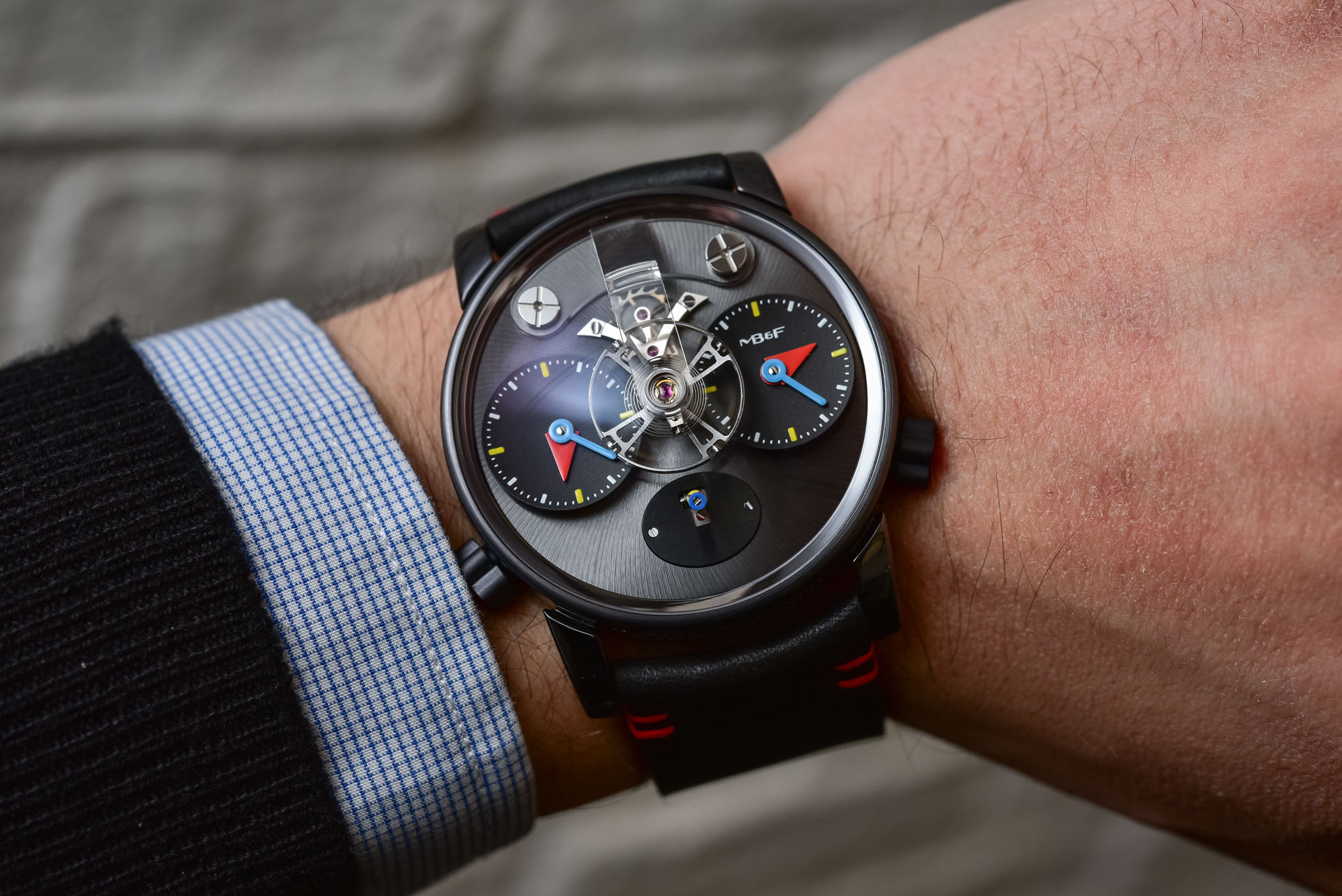
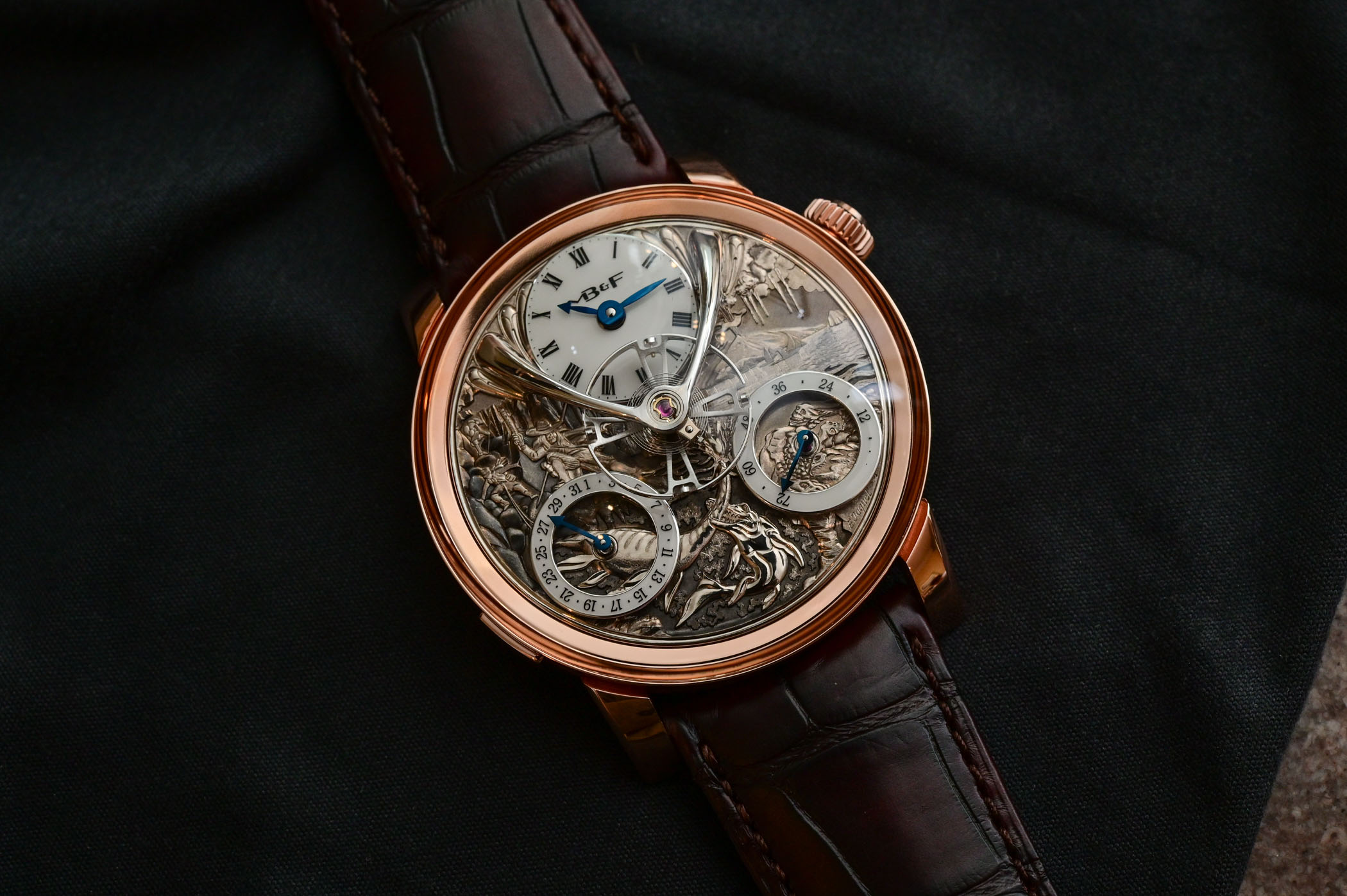
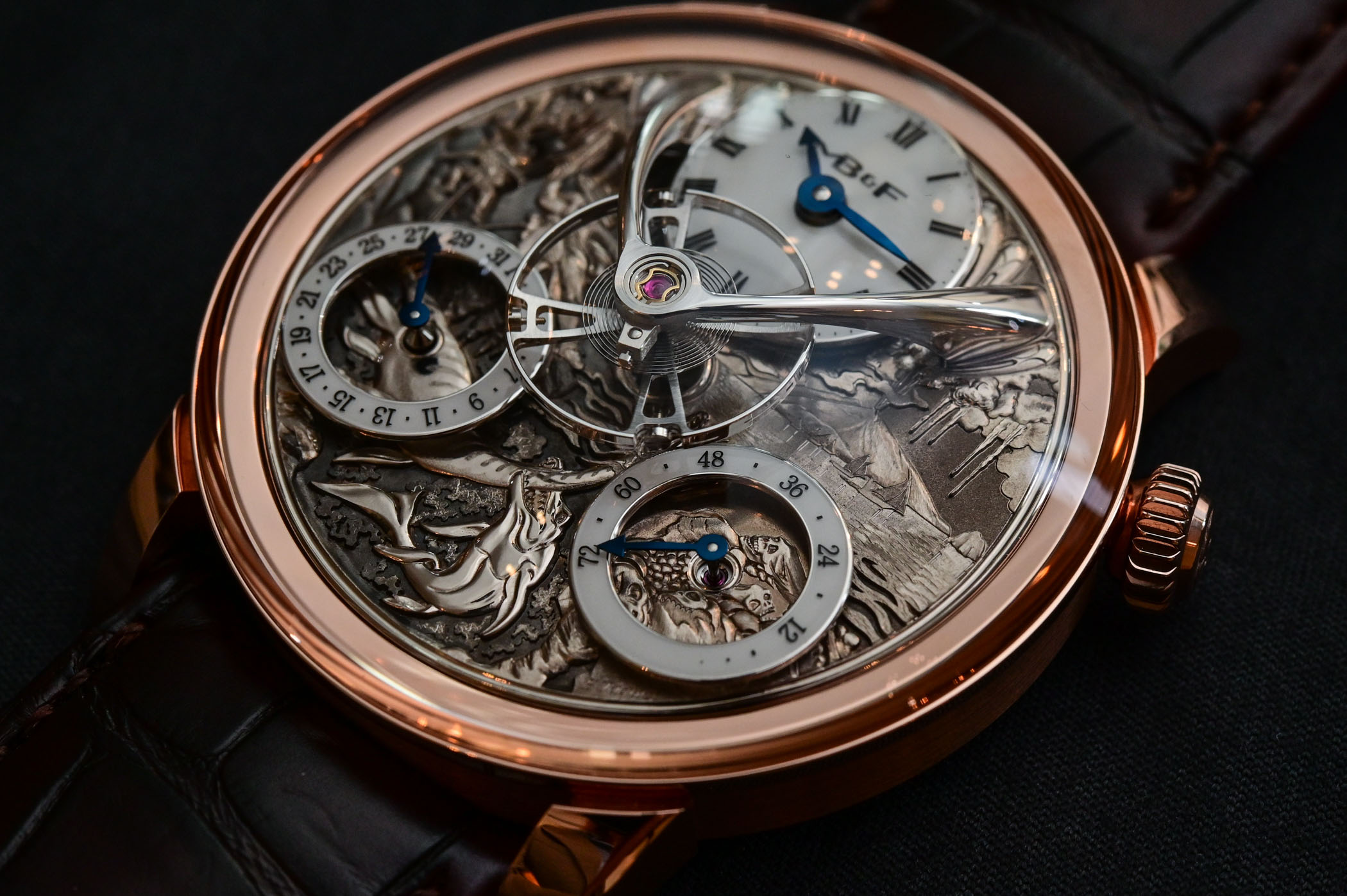
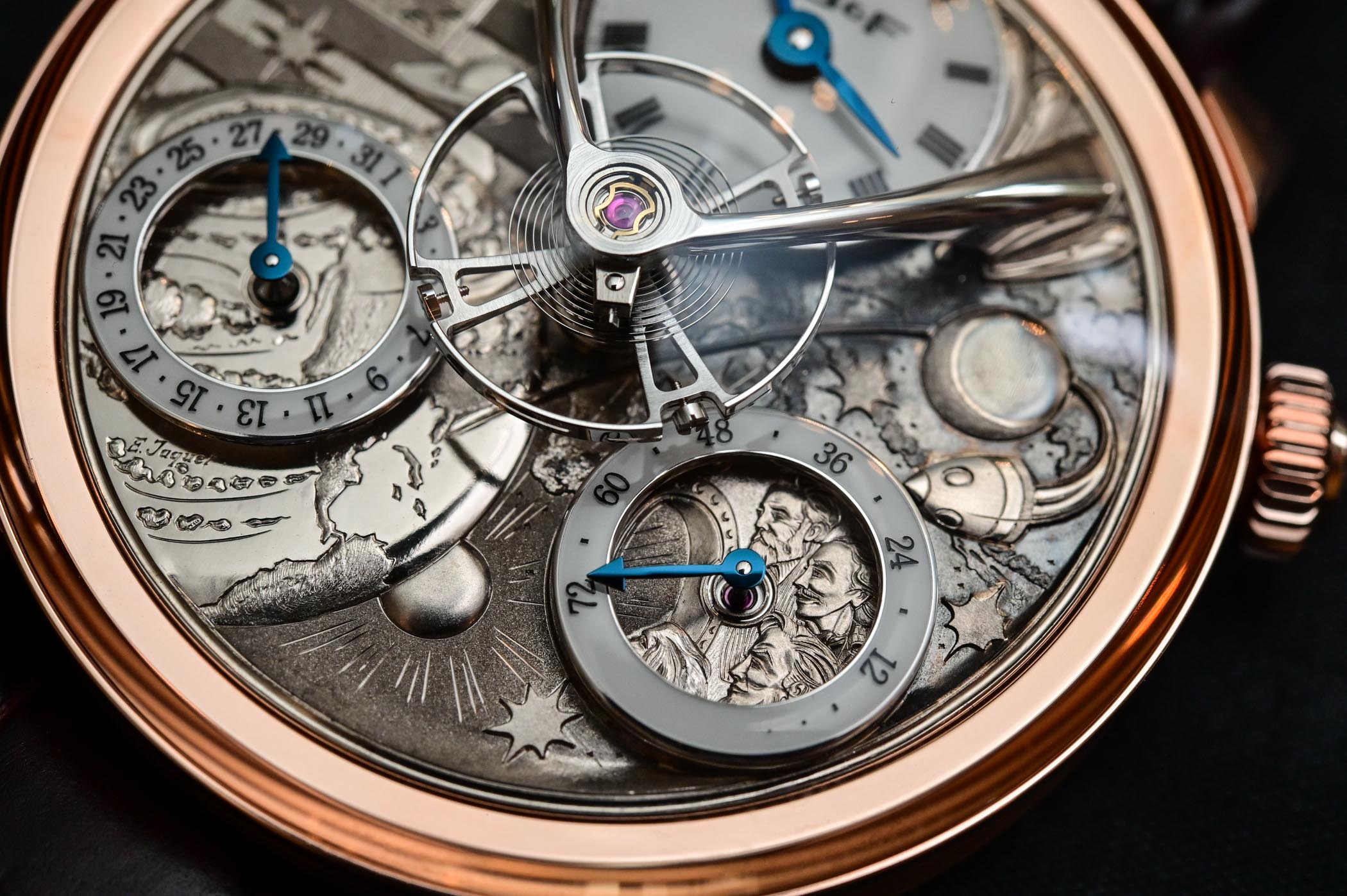
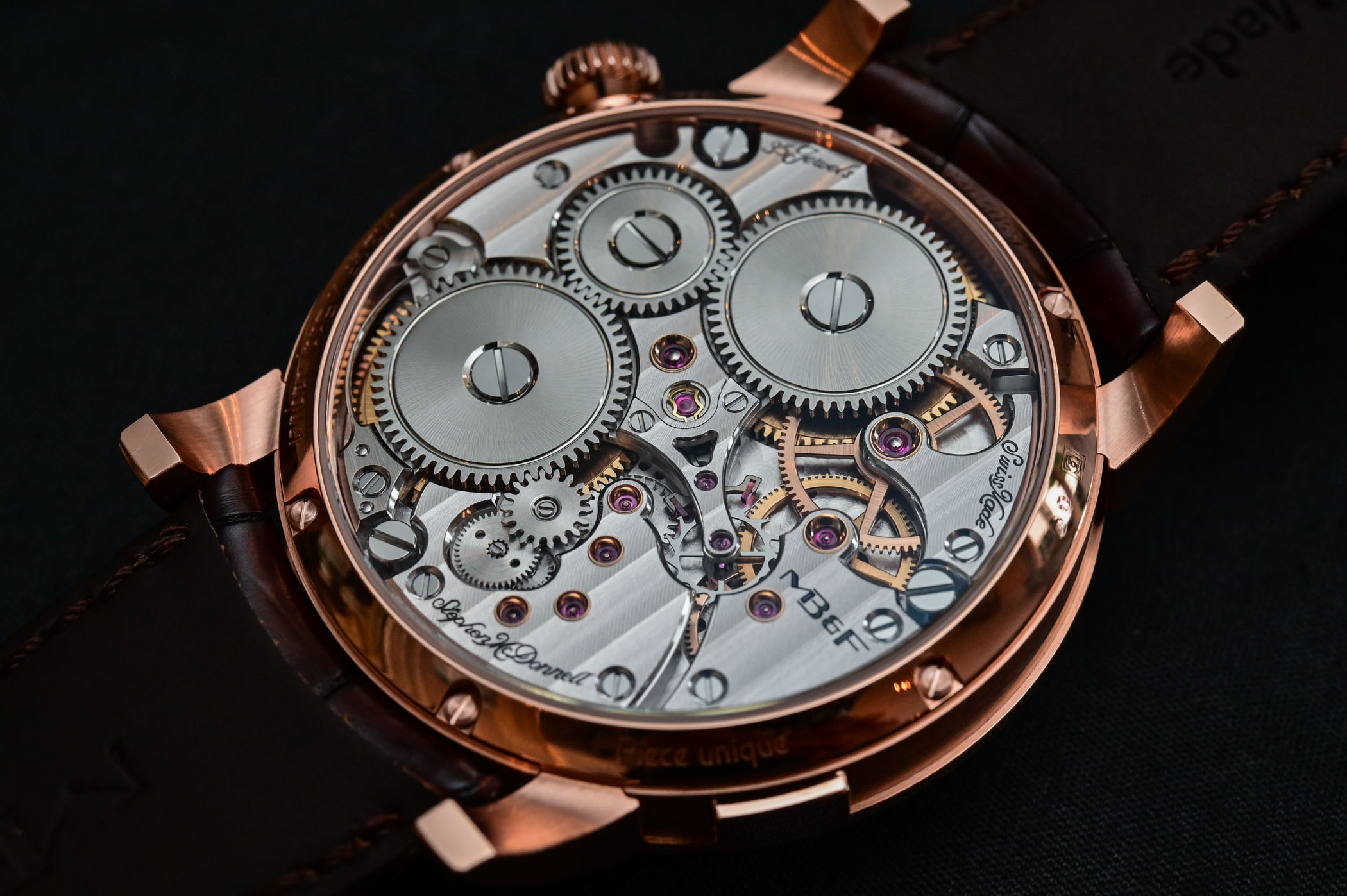
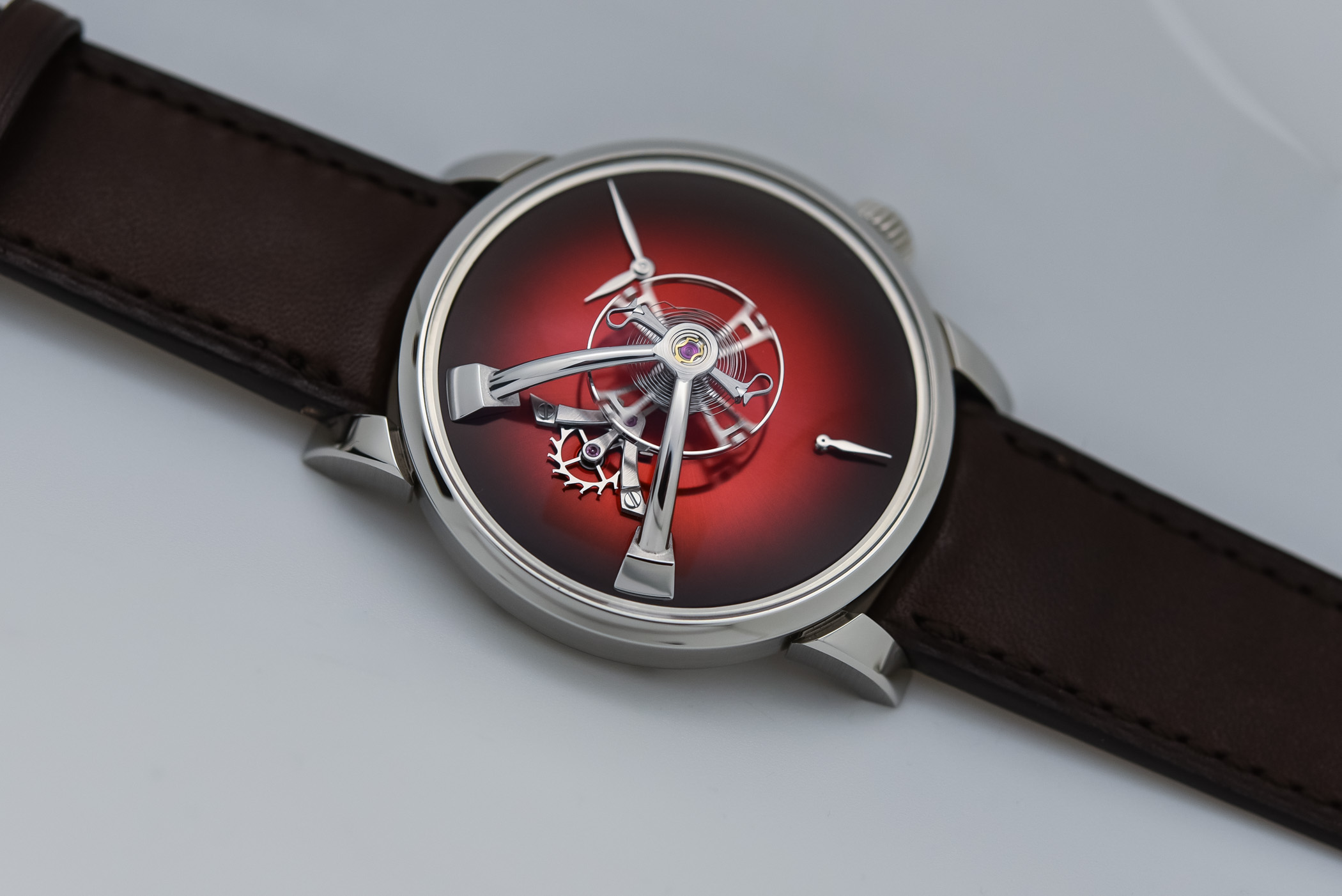
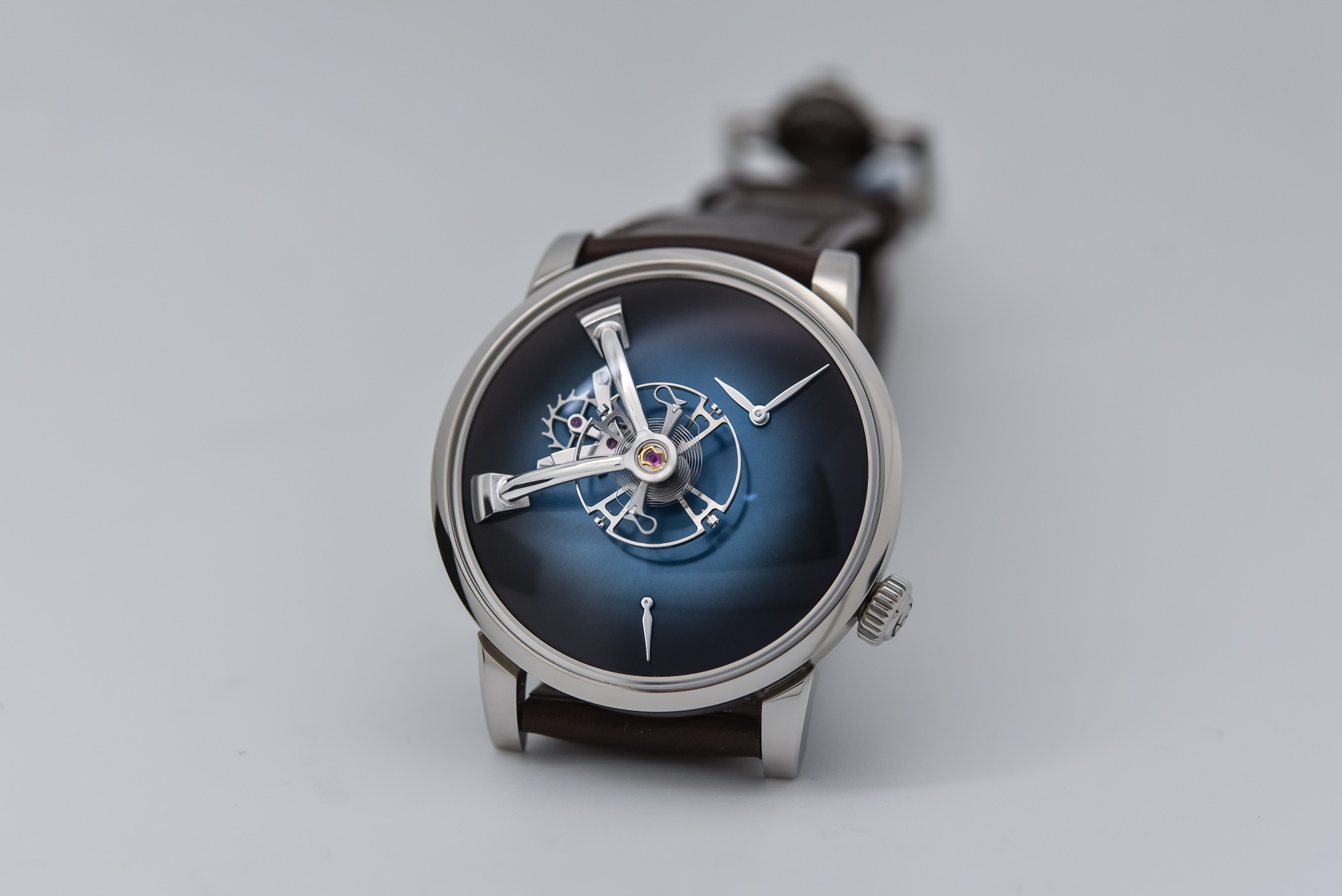
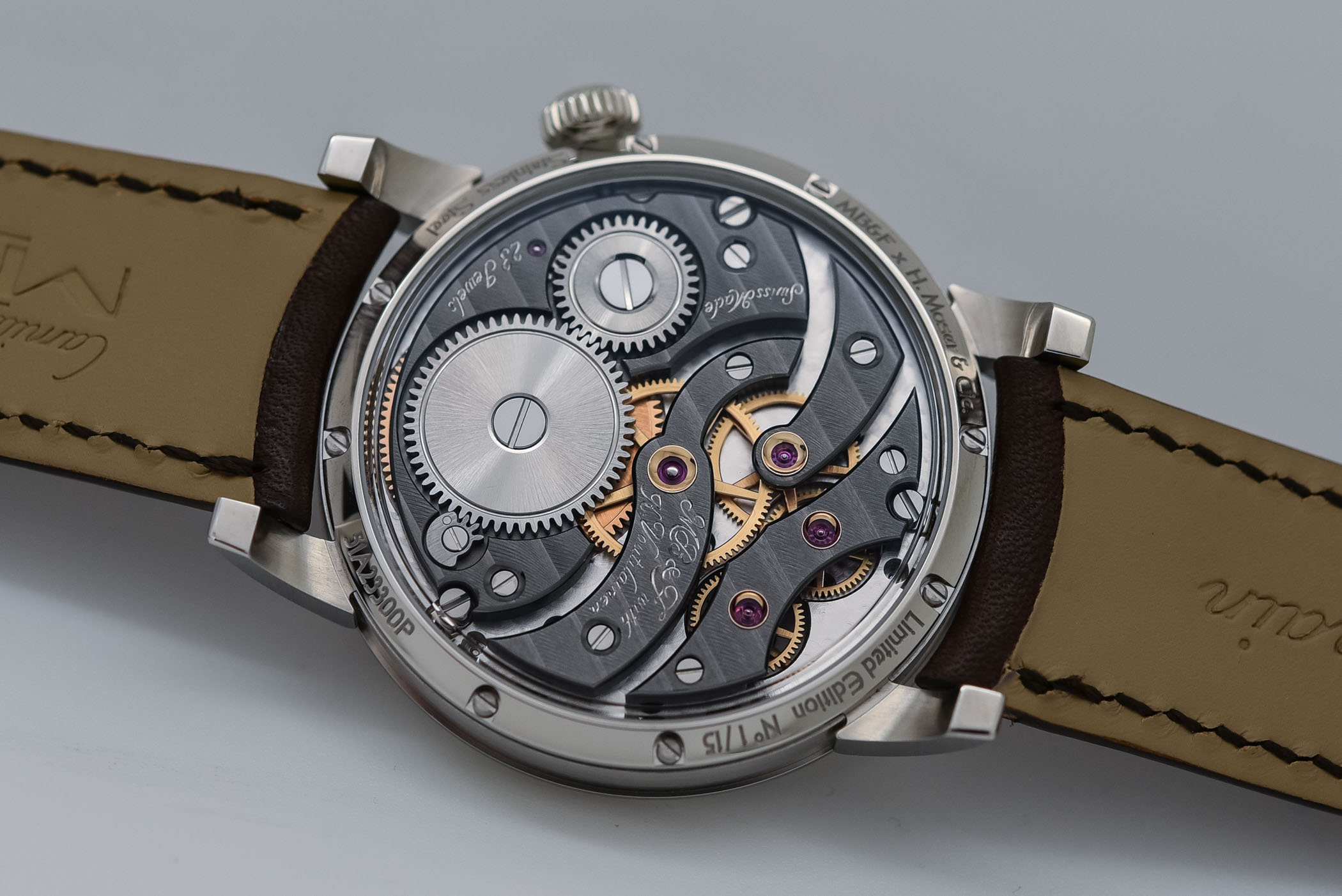
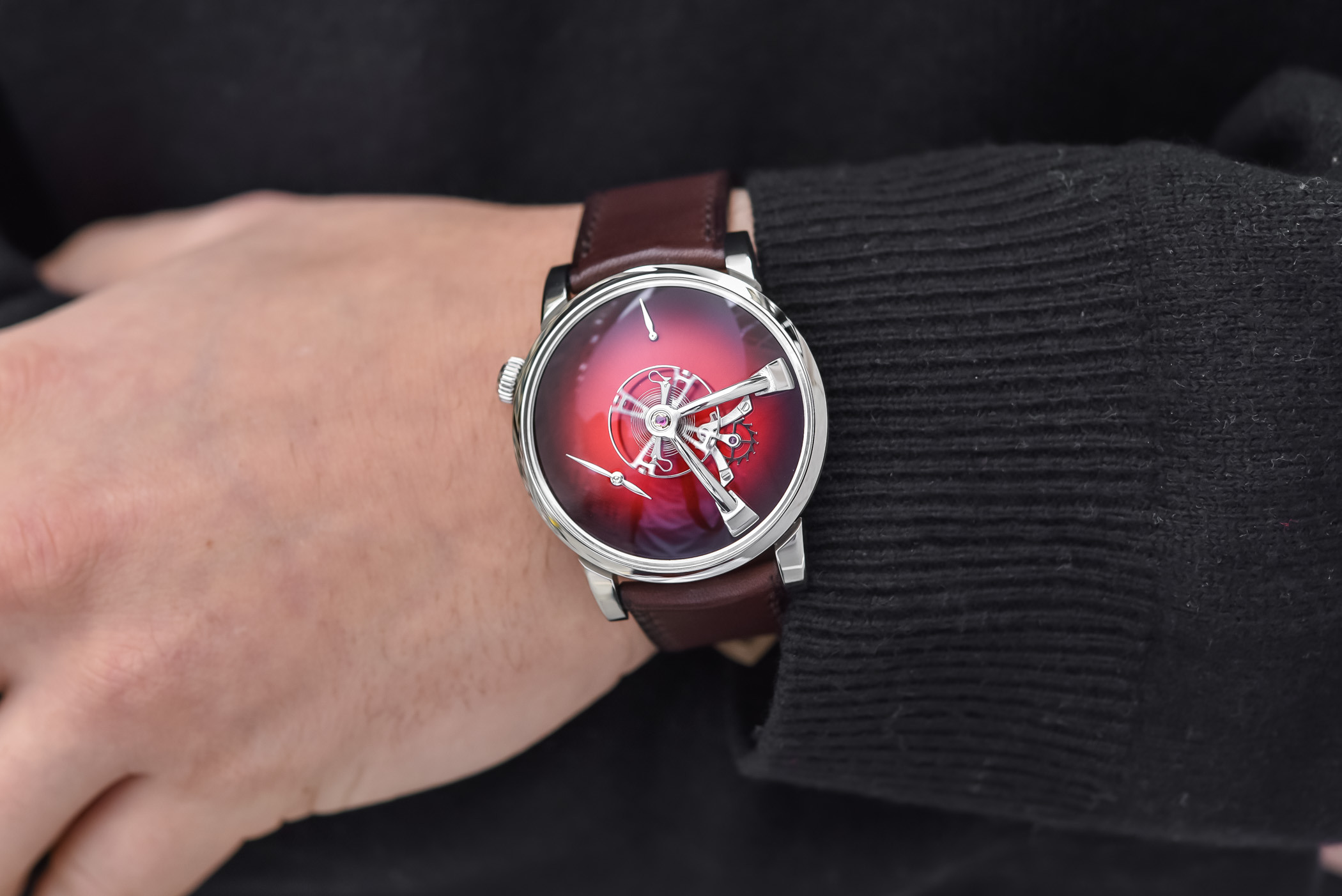
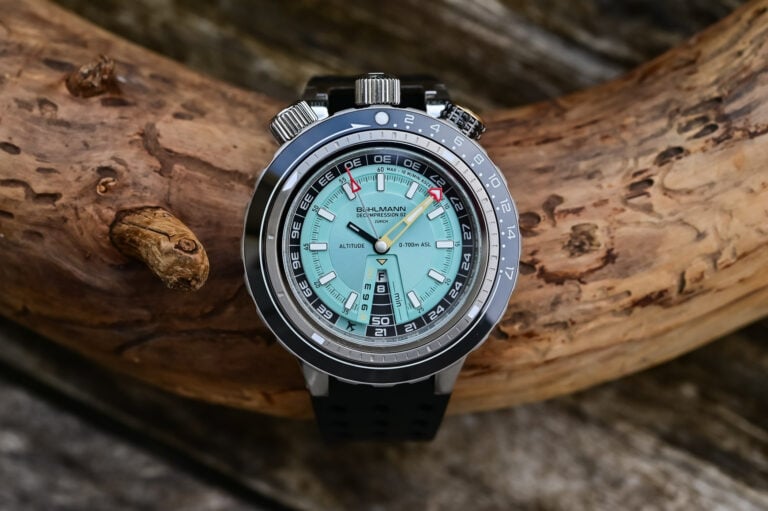
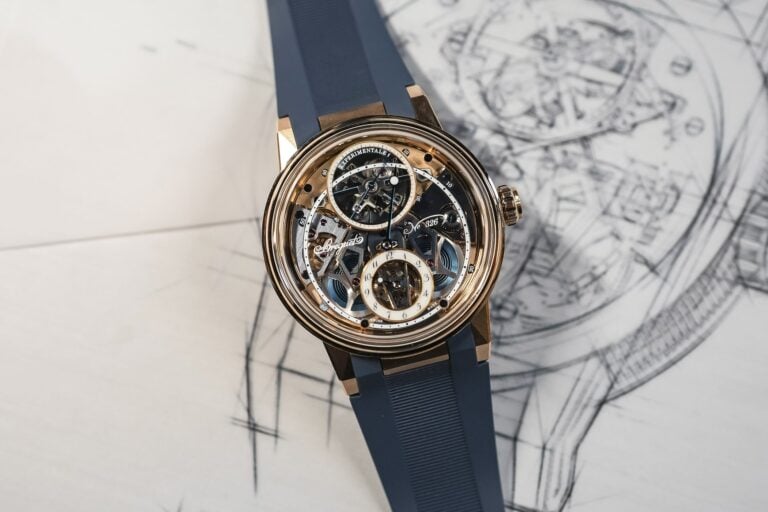
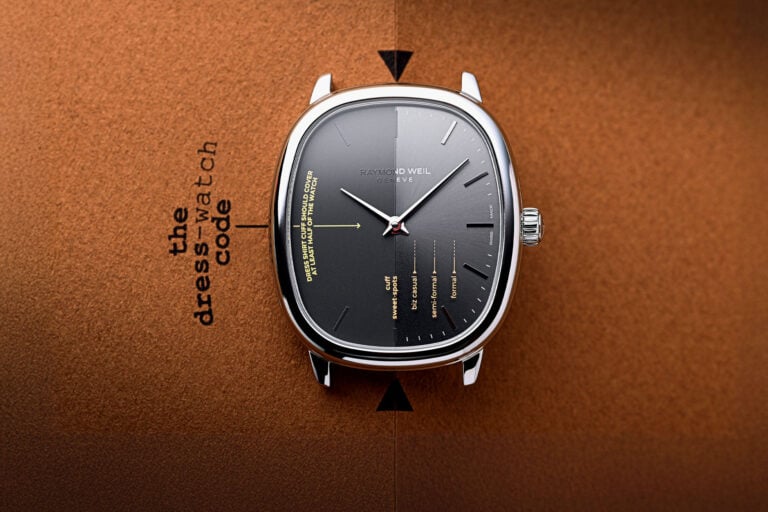
2 responses
Very interesting and well written article on a stunningly original watch manufacturer.
A breath of fresh air.
MB&F and its like-minded compatriots are exactly what is needed to keep the watch industry relevant and interesting in the digital age.
I want to like them because the quality is through the roof, but just not for me. Very comprehensive article though, Rebecca, nicely done.